Chabad Magazine Tuesday,
|
Menachem Av 2, 5774 · July 29, 2014
|
Editor's Note:
|
Dear
Friend,
During
the first nine days of the Hebrew month of Av, the Jewish people
experience sorrow and mourning. The destruction of the Holy Temples on
the ninth day of Av is both a historical fact and an eternal remembrance
of national, personal and spiritual loss that we re-experience every
year.
But
this year—amid the daily funerals of our beloved soldiers in Israel, amid
the terrors of our brethren in eastern Ukraine and throughout Israel,
amid growing antisemitism and the shattering of the once-assumed security
of our children everywhere—all this can lead one to the very edge of
despair.
Yet
here is the solution, wrapped in paradox: Our sages insist that our
mourning be accompanied by joyous gratitude to G‑d and the certain
anticipation of an immediate future when all that we have lost will be
returned to us in greater measure than before.
The
Nine Days is a time of action. We will learn more Torah—particularly,
advises the Rebbe, Rabbi Menachem M. Schneerson, of righteous memory,
teachings on the rebuilding of the Temple and the final redemption. And
we will do more mitzvahs,
which bring merit to those who are suffering most deeply, especially giving
charity generously, praying for their welfare from the depths of our
hearts and performing acts of kindness in their merit.
Yaakov
Ort in Jerusalem,
on behalf of the Chabad.org Editorial Team
|
Daily Thought:
Galut
It is not so much that we need to be taken out of exile.
It is that the exile must be taken out of us.
|
|
 The first nine days of the month of Av, and also the morning of the tenth,1 are days of acute mourning for the destruction of the first and second Holy Temples. The first nine days of the month of Av, and also the morning of the tenth,1 are days of acute mourning for the destruction of the first and second Holy Temples.
During this time, we don’t:
Eat meat or drink wine, for during this period the sacrifices and wine libations in the Holy Temple ceased.2 The exceptions to this rule are meat and wine consumed on Shabbat or as part of a meal that celebrates a mitzvah, such as a circumcision, bar mitzvah, or the completion of a tractate of the Talmud.
Launder clothing (except for a baby’s)—even if they will not be worn during the Nine Days—or wear freshly laundered outer clothing.3 Those who wish to change their clothing daily should prepare a number of garments and briefly don each of them before the onset of the Nine Days. Then it is permitted to wear these “non-freshly laundered” garments during the Nine Days.We don’t consume meat or wine, for during this period the sacrifices and wine libations ceased
Swim or bathe for pleasure.
Remodel or expand a home.
Plant trees to be used for shade or fragrance (as opposed to fruit trees).
Buy, sew, weave or knit new clothing—even if they will be worn only after the Nine Days.
Exceptions to this rule: (a) If you will miss a major sale, or if the garment will be unavailable later. (b) For the purpose of a mitzvah, such as purchasing new clothing for a bride and groom.
Cut nails during the actual week of the fast of Tisha B’Av—i.e., starting from the Saturday night before the fast until the conclusion of the Nine Days.
The Sephardic custom is to observe the stringencies regarding meat, wine and bathing only in the week of Tisha B’Av.
Some more observances:
The Sanctification of the Moon is postponed until after Tisha B’Av.
There is no law forbidding traveling during the Nine Days; however, it is customary to refrain from traveling (or engaging in any potentially perilous activity) during these days, unless it is absolutely necessary.
One may become engaged to be married during this period, but no celebration should be held until after Tisha B’Av.
Note: All these restrictions are in addition to the restrictions that apply during all of the Three Weeks.
Shabbat Chazon
The Shabbat preceding the Ninth of Av is called Shabbat Chazon—“Shabbat of the Vision.” This Shabbat’s reading from the Prophets begins with the words Chazon Yeshayahu, the “vision of Isaiah” regarding the destruction of the Holy Temple. The legendary chassidic master Rabbi Levi Yitzchak of Berditchev said that on this special Shabbat, every Jewish soul is shown a vision of the third Holy Temple. The purpose of this vision is to arouse within every Jew a yearning to actually see this edifice which will be built by G‑d, and to do as many mitzvot as possible in order to realize this dream. While this vision may not be sensed with the physical eyes, the soul certainly experiences this vision, and it affects the person on the subconscious level.
There is no mourning on Shabbat—click here for more on this topic.
If We try to moderate the sadness through participating in permissible celebrationspossible, this week’s havdalah wine or grape juice should be given to a child—younger than bar/bat mitzvah age—to drink.
Click here for the rules that apply if this Shabbat falls on the eighth or ninth of Av.
The Inner Dimension
“When the month of Av enters, we reduce our joy . . .”(Talmud, Taanit 26b)
The entire month of Av is considered to be an inopportune time for Jews. Our sages advised that a Jew who is scheduled to have a court hearing—or anything of a similar nature—against a gentile during this month should try to postpone it until after Av, or at least until after the Nine Days.
On the positive side, as we get closer and closer to the messianic era, when these days will be transformed from days of sadness to days of joy, we start to focus on the inner purpose of the destruction, which is to bring us to a higher level of sensitivity and spirituality, and ultimately to the rebuilding—with even greater grandeur and glory—of all that was destroyed.
We therefore try to moderate the sadness through participating in permissible celebrations. It is therefore the Chabad custom to have someone complete a tractate of the Talmud each day of the Nine Days, in order to infuse these days with permissible joy.
Click here for more on this topic.
FOOTNOTES
1. The Temple was set ablaze on the afternoon of the ninth of Av, and burned through the tenth.
2. Through custom, this prohibition has been expanded to include food cooked with meat. However, one may eat food that was prepared in a meat pot or utensil.
3. Shoes purchased specifically for the Ninth of Av—e.g., shoes made from canvas or rubber—may be worn even if they are new.
9 Days
|
|
Although their
mourning was prompted by a conquest, it was not Napoleon’s victory that
they were lamenting.
Based on the
teachings of the Lubavitcher Rebbe
After Napoleon conquered the city of Acre in northern Israel, he walked through the streets of the ancient seaport. Suddenly, his attention was caught by a group of people wailing bitterly.
Incensed at the thought that perhaps they were mourning because of his conquest, Napoleon sent agents to investigate. His agents returned and told him that it was a group of Jews who were mourning. Although their mourning was prompted by a conquest, it was not Napoleon’s victory that they were lamenting. It was the night of Tisha B’Av, the ninth day of the Hebrew month of Av. They were mourning the conquest of Jerusalem and the destruction of the Holy Temple that had taken place more than 1750 years previously.
Napoleon was moved. He exclaimed that any nation whose sense of history is so strong as to remember—and remember to the point of actual tears—what took place those many years previously will live to see that history become present again.
Parshas Devarim is always read before the fast of Tisha B’Av, the day on which we commemorate the anniversary of the destruction of the Temple by the Babylonians and the Romans. More importantly, it is a day when we focus on building from those ruins, seeing that exile is not in itself an end, but rather a phase in the progress of mankind to its ultimate goal—the future redemption.
Parshas Devarim—Shabbos Chazon
This week the Shabbos is given a special name, Shabbos Chazon, which means “the Shabbos of vision.” It refers to the haftorah read on this Shabbos, which begins: “The vision of Isaiah.”
Isaiah’s vision speaks of the retribution G‑d will visit upon the Jewish people for their sins. Conversely, however, the name of this Shabbos has a positive connotation. As R. Levi Yitzchak of Berditchev would say: On the Shabbos of Vision, every Jew receives a vision of the Third Temple.
Both of these interpretations relate to the fact that this haftorah was instituted to be read on the Shabbos preceding Tisha B’Av, the fast commemorating the destruction of the Temple and the exile of the Jewish people. The traditional meaning focuses on the negative, the severe descent of our people into sin. For, as the prophet warns, Israel will be harshly punished for her grave transgressions. The chassidic interpretation, by contrast, points to the redemption from that exile, alluding to a foretaste of the most exalted spiritual levels, a peek at the ultimate and most inclusive revelation of G‑dliness that there will ever be.
How can the two interpretations coexist? They are seemingly opposite.
Such a paradox, however, reflects the unique nature of the Jewish people. Our nation is prone to extremes—whether we are at the highest peaks or the lowest depths, we simply are not ordinary.
Why? Because our people, as a whole and as individuals, share a connection with the essence of G‑d.
The essence of G‑d is not computable; it doesn’t fit on a graph. Instead, it defies all definitions and foreseeable determinations, making rules rather than conforming to them. That essence was implanted in every one of us. Therefore we will be exceptional: at times sinking to the depths about which Isaiah spoke, and at times rising to the peaks that enable us to anticipate the revelations of the era of the redemption.
What is most unique is that the two extremes are interrelated. The descent leads to the ascent. G‑d structured the challenges of exile to compel us to express our deepest spiritual potential. And just as He presented us with these challenges, He gave us the ability to overcome them.
Looking to the Horizon
Our sages describe exile with the analogy of sowing seeds. Before a seed can grow into a flowering plant, its exterior husk must utterly decompose. Similarly, for the G‑dly core of the Jewish people to flourish, all the external dimensions of their personality must be stripped away.
In the analogue, the drastic descent that characterizes the exile wears away at our intellectual and emotional connection with G‑d. Without gentleness or mercy, exile tears apart the husky shells of our personalities. Layer after layer of who we think we are and what we’ve been trained to be, what we would like to be, is peeled away.
Ultimately, what is left? The very essence of the soul, the point within our being that is an actual part of G‑d. And when that essence is tapped, true growth begins. When this pattern spreads from person to person, the Jewish people blossom. In doing so, they spread the awareness of G‑dliness throughout the world, precipitating the dawning of the era of the redemption.
© Copyright 2014, all rights reserved.
|
|
|
More in 9 Days:
|
|
|
 My two-year-old came running up to me yesterday as I stood mashing potatoes for dinner and, with as much indignation as a two-year-old can muster, flung his finger in the general direction of his older brother and said, “He hit me!” My two-year-old came running up to me yesterday as I stood mashing potatoes for dinner and, with as much indignation as a two-year-old can muster, flung his finger in the general direction of his older brother and said, “He hit me!”
“Not true!” my four-year-old denied the allegations. “I didn’t hit him, my hand hit his face!”
I stood there for a moment, unsure how to proceed, until, after what was probably a full minute of silence, my four-year-old explained, “I didn’t want to hit him. It was an accident. So it wasn’t really me hitting him, it was just my hand hitting his face.”
I was struck by the depth of this four-year-old logic. If he had lifted his hand intentionally to hit his brother, then it would be fair to say that he had done the hitting, and that he had hit his brother. But since the blow was unintentional, it did not come from him, only from his hand, and he hadn’t hit his brother, only his brother’s face.
I directed both boys back to their trains with a warning to please be more aware of what their hands were doing, especially around faces. And then I stood for a while in the kitchen, watching them and thinking about the very compelling argument my four-year-old had just made.
There is action, and then there is the will that drives the action. They are not one and the same, but they are not really separate either. Imagine how painstaking it would be to have to issue an explicit command to your hand every time you wanted to move it, or to your foot if you wanted to walk or hop, or to your mouth to form a certain sound or word. Thankfully, that’s not how our bodies are designed. Instead, our neurons almost instantly transmit our will to the specific limb that will express it.
When you watch an artist paint a picture, what you see is the movements of the artist’s hand as he guides his brush over the canvas. You don’t see the firing of those many millions of neurons, bringing the messages from the artist’s will to his hand and guiding his hand to the brush, the brush to the paint and then to the canvas, to make the artist’s desire to paint a reality. Yet when you see the final masterpiece, you would never think that the artist’s hands created it by mistake.
The same is true of the world we live in. We see the various processes around us, but in truth there is an underlying will that guides each process. Unlike my four-year-old, though, G‑d doesn’t act without intent, and nothing happens by chance. Every occurrence is the express will of G‑d.
The Tabernacle and the Temple were designed to teach us how G‑d is present in every detail of the world, and the service performed therein was a further reminder of His presence and the ways in which we can connect to Him.
Each of the vessels of the Temple served as an expression of G‑d’s relationship with the world. Just like a mouth cannot walk and a foot cannot talk, each vessel was used for only its specific purpose.
The copper altar, upon which animals, meal cakes and wine were sacrificed, guided people to sacrifice their animalistic tendencies and give of themselves to G‑d. The incense altar helped further refine the relationship with the One Above. The menorah lit the Temple, spreading the light of G‑dliness to the world. The shulchan held the showbread, emanating the blessings of livelihood to the entire nation. Each vessel had a specific, manifest holiness.
But equal to, and possibly more important than, the vessels of the Temple were the walls that surrounded them. The Torah issues very specific instructions for the making of the curtains that served as walls in the desert, including which materials to use and what their dimensions should be. And most importantly, the curtains were fashioned before the vessels. These weren’t just any curtains; they were the walls of the house of G‑d, and they gave innate holiness to the vessels themselves. Beyond the manifest holiness of each specific vessel, the vessels were innately holy simply because they were found within the walls of the Temple.
This manifest and innate holiness can be seen in the entire world. Each moment manifests individually, like an individual piece of furniture, and some moments seem more holy and G‑dly than others. And each person has his or her own talents and strengths, and some seem more suited to the service of G‑d than others. At the same time, each moment and each person is part of a greater, innately holy whole. We are within the walls of creation, the whole of G‑d’s world, created by His word, and powered by the neurons of the universe—the will and desire of G‑d.
Just as every synapse and neuron is integral to the final action, and each brushstroke is integral to the final piece of art, so too each moment and each person is integral to the purpose of creation. It is our job to uncover this innate holiness in every moment and every person, so that the world can be filled with manifest G‑dliness in the most complete way possible, with the coming of Moshiach and the final redemption.
Based on the maamar “Mitzvas Binyan Mikdash” in Derech Mitzvosecha, by the Tzemach Tzedek.
Ester Shurpin lives with her family in S. Louis Park, MN.
© Copyright 2014, all rights reserved.
|
|
|
|
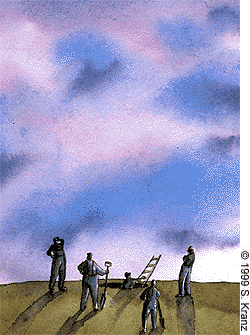 In any field of inquiry, the most interesting aspect is always thresholds. Interfaces between two systems. In any field of inquiry, the most interesting aspect is always thresholds. Interfaces between two systems.
To an ecologist, mountains are interesting for their alpine forests and vertically oriented fauna. Plains are interesting for their grasses and swamps. But nothing is as fascinating as the foothills, where two ecosystems meet.
One of the most interesting (and useful) fields today is that of “human interface”—the place where people and their machines meet. And then there is the study of chaoplexity—the fascinating border between rigid order and total randomness, where things such as amoebas, bond traders, Chabad House rabbis and the like occur. In halachah (Torah law), there is much discussion on the status of twilight—the gray area between when day stops and night begins. A gateway is one of the most common metaphors of Torah: a place where you are neither in nor out, but part of both.
Torah generally talks in terms of dual systems: heaven and earth; G‑d and man; creator and created; nothingness and something. So if we want to get into fascinating territory, we can ask: Where do they meet, and what happens there?
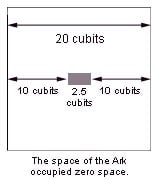 The first description of such a place was given by Jacob, the third of the three fathers of the Jewish people. On his way leaving the land of Canaan he slept at a place and dreamt of a ladder with messengers of G‑d ascending and descending. When he awoke, he exclaimed, “Y‑H‑V‑H (we pronounce that ‘Havayeh,’ as the Torah instructs us not to pronounce the four-letter name of G‑d the way it is written; more about this name later) is in this place, and I didn’t realize!” Once this realization had hit him, he trembled and said, “This place is awesome!” (The classic Aramaic translation reads, “This is not a normal place.”) And then, “This could only be the house of Elokim, and this is the gateway of heaven!” The first description of such a place was given by Jacob, the third of the three fathers of the Jewish people. On his way leaving the land of Canaan he slept at a place and dreamt of a ladder with messengers of G‑d ascending and descending. When he awoke, he exclaimed, “Y‑H‑V‑H (we pronounce that ‘Havayeh,’ as the Torah instructs us not to pronounce the four-letter name of G‑d the way it is written; more about this name later) is in this place, and I didn’t realize!” Once this realization had hit him, he trembled and said, “This place is awesome!” (The classic Aramaic translation reads, “This is not a normal place.”) And then, “This could only be the house of Elokim, and this is the gateway of heaven!”
It was more than seven hundred years before Jacob’s vision could be fulfilled, when King Solomon built the Holy Temple on that mountain, placed the Holy of Holies around that spot, and placed the holy ark on the rock where Jacob had laid his head to rest. The rabbis of the Talmud call that rock “the foundation stone”—because, they say, from it the world was begun. Read that as “the origin of something from nothing, and the place where the two meet.”
What happened in that space? It met with anti-space. This is how it worked:
The chamber of the Holy of Holies measured twenty cubits by twenty cubits. The ark was placed in the center, measuring two and a half by one and a half cubits. From the southern wall of the chamber to the adjacent side of the ark measured ten cubits. The same measurement was taken on the north side of the chamber.
You’re reading correctly: The ark took up no space. Or, to be more precise, from the frame of reference of the dimensions of the chamber, the ark occupied no space. The ark itself had to take up two and a half by one and a half cubits, because those are the dimensions specified for it by the Torah in order to be an ark that can go in this chamber and not take up space.
To get to the point: Space and non-space met, but neither canceled out the other. Which is exactly what Jacob said, “Havayeh is in this space!” and yet, “This is the house of Elokim.”
Jacob found himself in a place that expresses the essence of Torah. He found himself between two expressions of the one G‑d: Havayeh and Elokim.
Pantheism and idolatry arose by separating these two manifestations of the same G‑d. All people recognize that there are forces of nature. Some are smart enough to realize the unity of all these forces from observing how they harmonize together and are expressed in similar patterns. The ancients created from this understanding a sophisticated pantheon of divine beings. The more enlightened amongst them thought of these idols as mere reflections of the forces of nature. Yet, to this day, most people still accept these forces as being absolute and necessary. A world without gravity or electromagnetic waves is almost as unthinkable as a world without TV. Never mind the absence of time, space and logic themselves.
G‑d as the force behind all natural forces is expressed by the name Elokim. When the Torah discusses the creation of the world by ten sayings, it uses this name, as in “Elokim said, ‘It should be light’—and there was light.” So this is G‑d expressed within time and space and all that we can observe. G‑d as He is immanent.
But at the essence of everything is something that is beyond all of them. Something that cannot be defined as the perfection of them, nor as the absence of them. Something that cannot be defined at all. Havayeh is G‑d as He is beyond all that can be known. Transcendent. “I am Havayeh, I have not changed.” Beyond time and space and any reasoning we could apply. The very source of all being. As Maimonides writes, “If He is, then all else is. But if He is not, then nothing else can be.” Miracles, Torah and tzaddikim are manifestations of Havayeh in the world.
Interestingly, the ancient pantheons, from Egypt to Norway, generally included an original god from whom all things began. But that godhead remained entirely aloof from the whole hierarchy. After all, getting involved in the petty world that arose from his essential being would contaminate his perfect oneness. And so Pharaoh said to Moses, “Who is Havayeh that I should listen to His voice?” Pharaoh didn’t deny the existence of such a being, just the idea that He would care to mix into Egypt’s internal politics.
Abraham was the first to smash this dichotomy. He introduced the idea that the same One G‑d who originated all things, He also has an intimate concern about what goes on down here. Until Abraham, the Midrash says, G‑d was L‑rd of the heavens. Abraham made Him G‑d of heaven and earth. Abraham said, “See all these forces of nature? All your gods of wind and fire and love and war and fertility and playfulness? They are no more than manifestations of a single, transcendent being who does not change and from whom all things come. As He can be found infinite and unchanging at the essence that precedes all things, so He can be found in the ephemeral, temporal world in which we live. Havayeh is Elokim. In truth, there is nothing else but Him.”
Jacob, Abraham’s grandson, was delighted to find a place where there was no doubt as to his grandfather’s wisdom. He had found the place where space began, the one place which was not dominated by G‑d as Elokim, but where Havayeh is in this place. He envisioned a time when his own descendants would build a house there, a means by which such a revelation could be captured and projected out into the entire world. Until “No one will teach his fellow, saying, ‘Know Havayeh!’ because all of them will know Me, from their smallest to their greatest, says Havayeh.”
Although that is a nice place to end, there is a question left that needs to be answered:
Returning to the space of the ark that took up no space, you may ask: How could space remain in the midst of a revelation of non-space? Space is a limitation. When all limitations are blasted away by a revelation of Havayeh, space should altogether disappear. Expecting otherwise is like expecting the shadows to remain when all the lights are turned on.
An easy answer is, “It’s a miracle. G‑d can do anything.” However, that’s a last-resort answer. First we need to see if there’s something we can sink our teeth into, before declaring it out of our bounds.
One way out is to ask, “Perhaps our understanding of space is not what space really is?” By acknowledging that there could be non-space, we have already cast away the impression that space is an absolute given, something that just is and must be. The same G‑d who created a world bound by time and space could have come up with something else altogether—although we creatures of time and space would be hard put to imagine such a thing.
But we could go even further: Is space a static thing? Or is it an event which is continually being renewed out of the void?
If we choose the second option, we can then see space itself as just another expression of that which is beyond space. The One G‑d expresses Himself as non-space and as space—but He is neither. And the very fact that the two can coexist is a demonstration of this idea: that He is neither of them, but rather that which is beyond both.
This is the connection between this space and the third of the forefathers: Although the world is generally a binary place, there is a third factor, that which binds and unites all opposites together—even space and non-space. And that, too, is the revelation exemplified by the Third Temple, may it be built very soon, sooner than we can imagine.
Based on “Gadol Yihyeh 5722,” a discourse by the Lubavitcher Rebbe.
Rabbi Tzvi Freeman, a senior editor at Chabad.org, also heads our Ask The Rabbi team. He is the author of Bringing Heaven Down to Earth. To subscribe to regular updates of Rabbi Freeman's writing, visit Freeman Files subscription.
© Copyright 2014, all rights reserved.
|
|
Israel at War
|
|
|
The deadly
network originates from basements and private homes in Gaza and extends
into Israel—a tool for mass terrorist attacks against Jews.
By Uriel Vigler
The current war with Hamas is focusing on a new and frightening element, one which did not feature prominently in any previous war. Until now, our wars have included soldier-to-soldier combat, tanks, planes, bridges, ships, airports and weapons, but during Operation Protective Edge, much of the focus has been on a new threat: the tunnels.
For the first time, the threat is not above ground; it's hidden below. Over the years, Hamas has created a virtual labyrinth of tunnels beneath the ground. The deadly network originates from basements and private homes in Gaza and extends into Israel—a tool for mass terrorist attacks against Jews.
In order to counter this threat, the IDF has had to dig deep, under hospitals, mosques and private homes, where they've discovered caches of weapons, guns, machine guns, RPG rocket launchers, tranquilizers, IDF uniforms and more—all with the potential to inflict untold harm on the Jewish nation.
Operation Protective Edge has exposed these tunnels, but it has also created a new kind of tunnel: tunnels of love.
During this war, we've dug deep into ourselves and discovered powerful tunnels of love crisscrossing our nation, connecting us to one another and to our brothers and sisters in Israel. We are, regardless of outward differences, a nation that cares deeply.
My brother, Dr. Motti Vigler, chief of hand surgery at Rabin Medical Center, dropped everything this week in order to attend the funeral of someone he had never met. Lone soldier Sean Carmeli was killed in battle, and his family all live in America. When my brother arrived, he discovered 20,000 people had come to the funeral to honor this brave hero. A day later, another lone soldier, Max Steinberg, was killed, and 30,000 people showed up for his funeral as well.
And the tunnels of love continue to expand and extend. At the shiva, 300 people, almost all of them complete strangers, showed up to comfort the parents of these brave young men. Strangers on the streets show an incredible amount of care and concern for one another, even during these most stressful times. A stranger uses his body to shield a father and son from a rocket attack. Breslever chassidim dance with soldiers on the front lines. Chabad brings care packages. People from all walks of life, from all over the world, are connecting through tunnels of love and compassion to provide the IDF soldiers with whatever they need.
Hamas may have built tunnels of terror, but we are building and maintaining tunnels of love. We may be different on the outside—one seems to be secular, another ultra-Orthodox, one a kibbutznik, another chassidic—but when it really matters, we know how to ignore the external differences and dig deep, focusing on our commonalities: we are one nation, with one heart and one soul.
We are currently in the annual three-week period of mourning for the destruction of the Holy Temple. The Temple was destroyed because of acts of wanton hatred, and it will be rebuilt through acts of love and kindness.
So, nu, G‑d, what are you waiting for?!
My thanks to Rabbi Mendel Prus and Yaara Bank-Plotkin for the inspiration for this article.
Rabbi Uriel Vigler is the director of Chabad Israel Center in the Upper East Side of Manhattan.
© Copyright 2014, all rights reserved.
|
|
|
More in Israel
at War:
|
|
|
|
|
|
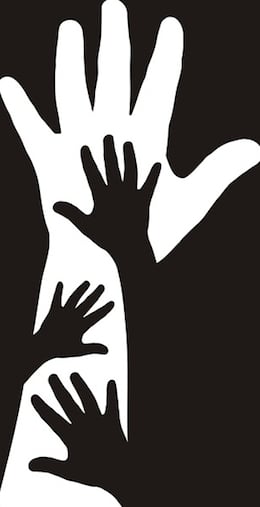 Strange Story Strange Story
It’s one of those things you’ll hear over and over in the Jewish world: Causeless hatred destroyed Jerusalem. Fix the hatred and rebuild Jerusalem.
The source is a passage in the Talmud, Yoma 9b. First, the Talmud describes the situation that brought about the first destruction of Jerusalem and its Temple by the Assyrians: rampant idolatry, wanton murder and flagrant adultery. And then the sages ask—and you can feel the agony and anguish in the question:
And the Second Temple, when they were occupied in Torah, mitzvahs and acts of kindness—why was it destroyed?
Because there existed causeless hatred.
It was a time when study of Torah flourished, and along with that, many, many good deeds.
Read that carefully. The Jews weren’t just learning Torah, not just doing mitzvahs, not just acting out kindness—they were fully occupied in these things. From all the evidence we have, it was a time when study of Torah flourished, and along with that, many, many good deeds. People were caring for each other. Not exactly the bloodbath of in-fighting and hatred that one might expect to bring upon us almost two thousand years of exile.
The puzzle gets deeper. There’s one (just one) story to illustrate that causeless hatred, found in the Talmud, Gittin 55b:
Due to Kamtza and Bar Kamtza, Jerusalem was destroyed.
You see, there was a man who had a friend named Kamtza, and a rival named Bar Kamtza. This man made a feast. He told his attendant, “Go and bring me Kamtza!”
But instead, his attendant brought Bar Kamtza.
When this man found Bar Kamtza sitting at his feast, he said to him, “Just a minute! You and I are rivals. What are you doing here? Get up and get out!”
Bar Kamtza replied, “Since I have already come, let me stay and I will pay for whatever I drink and eat.”
The man answered, “No!”
Bar Kamtza replied, “I will pay for half the feast.”
The man answered, “No!”
“I will pay for the entire feast!”
Again, “No!”
And then this man grabbed Bar Kamtza, picked him up and threw him out.
Bar Kamtza said to himself, “The rabbis were sitting there. They didn’t protest. That means they were pleased that I was thrown out!”
So Bar Kamtza devised a means to slander his own people, convincing the Caesar that they were planning a revolt. Within three years, Jerusalem was in ruins, the Temple Mount flattened, and our long and arduous exile had begun.
Now, hold on a minute:
It’s very nice that the rabbis are blaming themselves for the disaster, taking the load of guilt upon themselves. Very Jewish.
And yes, such an act of insensitivity was quite inexcusable.
But let me ask just three simple questions:
One: For this, Jerusalem was destroyed? This was the worst sin that could be found at the time?
Two: The story gives no hint of who was this man, or who were the rabbis sitting mutely around. The story provides only two names: “Due to Kamtza and Bar Kamtza, Jerusalem was destroyed.”
Now, Bar Kamtza may not have been the most endearing fellow to begin with—it’s not your average mean neighbor who goes slandering the entire nation to the Caesar because his feelings were hurt. You might even argue that his reputation somewhat justified the treatment he received.
But Kamtza—what on earth did Kamtza do wrong? He didn’t even come to the party! Why is the disaster blamed on him?
How can exile and dispersion throughout the globe rehabilitate a crime of insensitivity at a party?
Three—and the most important: The punishment must fit the crime—because it’s meant to fix up the crime, to rehabilitate the criminal so that this won’t happen again. Now explain to me: How can exile and dispersion throughout the globe rehabilitate a crime of insensitivity at a party?
Mystery Solved
In our series Is Midrash For Real, we explained how to read stories of this genre, known as midrash. We also introduced one of the masters of midrashic interpretation, the 16th century Rabbi Yehuda Loewe, known as the Maharal of Prague. Here, too, the Maharal comes to the rescue.1
The first thing you have to know is that if the midrash tells you a name, there’s a reason that name is mentioned. The name means something—and in this case, something thematic to the story.
“What is a kamtza?” asks the Maharal. For one thing, kamtza is Aramaic for grasshopper.2
Here you have an interesting creature. It travels in a very great mass (well, certain ones do, and when doing so, we call the same creature locust, or in Hebrew, arbeh—related to the word ribui, meaning many), yet it has no society. As the proverb goes, “There is no king among the locust.”3 No leader, no pecking order, no families—just a mass of alike creatures blown in by the wind.
So, too, says the Maharal, we can have a mass of people that live together, work together, even do nice things for one another—and yet have nothing holding them together other than circumstance. Like locust, they are a multitude of persons, but not a people. Quite simply: They are living in the same country, keeping the same customs, and so, they might as well get along.
What’s so terrible?
Because that is not the Jewish People upon which the Temple is built.
The First Temple, writes the Maharal, was built upon the sanctity of the Land. The Land of Israel demands sanctity—especially Jerusalem, and especially if you want a Temple there. Once that sanctity was profaned with adultery, murder and idolatry, the foundation was gone, the Temple could no longer stand and the people were forced to leave.
The Second Temple, however, was built upon the integrity of the community. The people returned on their own initiative from Babylon and set themselves the task of resettling the land and rebuilding the Holy City of Jerusalem and the Holy Temple. They came as a single whole, as one person with one heart. And upon that Jerusalem and the Temple were built.
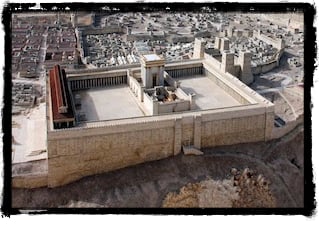 They came as a single whole, as one person with one heart. And upon that Jerusalem was built. They came as a single whole, as one person with one heart. And upon that Jerusalem was built.
So when that integrity of the community began to crumble, the entire foundation of the Temple and Jerusalem crumbled. Yes, there were Jews who were friends. But the friend himself was a kamtza—an ally for the sake of divisiveness. As the Maharal explains, when people want to create division, they take one person as an ally—in this case, Kamtza—so that another can be the foe—Bar Kamtza. And that itself was a sign that the entire system had been undermined. It was a kamtza society—a mass of individuals held together by the wind, by circumstance.
The Dispersion Cure
So how is exile and dispersion the prescription to heal a crumbled community?
Simple, writes the Maharal: Because in such an exile, Jews are no longer a single nation by geographical circumstance—not even eating the same food, dressing the same dress or speaking the same language. Scattered to every corner of the planet, geographically, culturally and psychologically, we are forced to discover the essential oneness of our people that was so easily discarded when living together in one land.
And we have. We have discovered it in such a way that it can never again be lost.
Which is amazing.
Yes, I can hear the protests, “Not good enough! There’s quarrels! There’s hatred—even self-hating Jews! And there’s disdain of one group for the other!”
Those are the idealists.
When Jerusalem was destroyed, there were two schools of thought among the sages—the Shammai-niks and the Hillel-niks. Shammai-niks were idealists. Hillel-niks said, “Let’s see what the people can handle.”
Fortunately for all of us, the Hillel-niks won out. Because otherwise, this exile would last forever.
If you’re a pragmatist, if you can take into account human nature, it’s amazing.
The Oneness Unfolds
Three teenage boys were abducted and in whatever Jewish place of worship I might walk into, for three weeks, they were praying for those boys. From Singapore to Santa Cruz, from the Satmar Shteibel to the Reform Temple, the names of these boys were on the lips and in the hearts of those who came to pray. The tweets, the Whatsapps, the FB likes were coming from every sort of Jew imaginable. People who have never lived in Israel, perhaps never even visited the place cared. Truly cared.
A people that has been spread throughout the world for two millennium are praying for these kids, lighting Shabbat candles for these kids, united for these kids, because they’re Jewish kids. Because we are one.
After three weeks, on the third day of the Jewish month of Tammuz, we heard the news and the hearts of Israel across the globe dropped in unison. Many were angry with G‑d—how could He allow all these prayers, all this unity, to just dissipate into the void?
But it turned out there was no void.
It turned out that those who wish to destroy us had built a vast network of tunnels of terror, an entire hidden city connecting lethal munitions and technology with armies of terrorists, leaking into nursery schools and dining halls of Israeli communities in Israel’s south.
The plot was more demonic than any heard in history: to massacre and abduct hundreds of Israeli children and civilians on the holy day of Rosh Hashanah. And then to attack from land, air and from sea. Any missile we would fire would mean an instant casualty for Israel, regardless of where that missile would strike. As one MK put it, the calamity would have been far beyond anything Israel had ever seen, including the tragic casualties of the Yom Kippur War.
Looking from the outside, it was the abduction of those three boys that set off a chain reaction of events that thwarted a nightmare. Upset at our incursions to arrest the kidnappers, our enemies fired their missiles too soon. We were forced to invade. And as we took prisoners of war, they revealed to us the monstrous plan.
They built tunnels of terror; we built tunnels of love.
But looking deeper, as Rabbi Uriel Vigler expressed so well, we were saved by the tunnels we ourselves had built. Tunnels beneath the surface, connecting one Jew in this land to a Jew in another, one Jew at this end of the spectrum to a Jew at the other—tunnels, not underground, but in the heavens; tunnels, not of terror, but tunnels of love.
A tattoo-covered young Jew sitting on a flight to Israel discovered that the Modern Orthodox rabbi next to him was on a mission—to deliver consolation from his community to the families of those three boys. That sparked something inside him. He asked to borrow the rabbi’s tallit and tefillin. And then he said, “Rabbi, in Seattle, where I’m from, I don’t know where to get these black leather boxes. But if I had them, I would wrap them every day.”
At which point, a Satmar chassid—what the media calls ultra-ultra-orthodox—pops up his head, leans forward from the seat behind and says, “Sweet Jew, if you promise you will wrap them every day, I will FedEx them to you at no cost.”
If the three would be engaged in dialogue, they would probably rip into each other over almost every subject under the sun. But as a people, they are one, with one Torah, one heart and one set of black leather boxes.
And now, we all pray for the safety of those heroes endangering their lives so that our people in Israel can live in peace. We pray together for the safety of every person under attack, because each life is precious without measure. We check the news each morning as though it were happening right here. And it is, because a Jew in Paris, Berlin, Los Angeles or Calgary may be attacked, G‑d forbid, because of what his or her fellow Jews are doing to save themselves in Israel. Our enemies know well that we are one.
Exile and dispersion produced a miracle. It brought out an organic, irreducible oneness of our people that could not otherwise be imagined.
This exile has done it’s job. It’s time now for it to end.
Rabbi Tzvi Freeman, a senior editor at Chabad.org, also heads our Ask The Rabbi team. He is the author of Bringing Heaven Down to Earth. To subscribe to regular updates of Rabbi Freeman's writing, visit Freeman Files subscription.
FOOTNOTES
1.In his Chidushei Agadot to the story in Gittin.
2.See Ediyot, chapter 8. On the words (Numbers 13:33), “…we were in their eyes as grasshoppers,” the classic Aramaic translation of Onkelos translates grasshoppers as kamatzim.
3.Proverbs 30:27.
© Copyright 2014, all rights reserved.
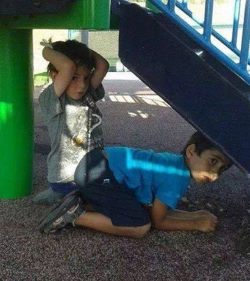 I’m sorry, my dearest little one. I’m sorry, Mussie. We can’t go to the slide park today. I’m sorry, my dearest little one. I’m sorry, Mussie. We can’t go to the slide park today.
You’re not even two, but you know exactly how to melt my heart. You tilt your head slightly to your right, and look up at me with your beautiful eyes. With the sweetest tone of voice, like a soft harp in the wind, you plead with me.
“Please, Mum? Please go slide park? Slide park fun! Please, Mum?”
Those eyelashes. Big dark eyelashes batting at me, framing your wide innocent eyes. I want to say yes.
“How about we go to our park instead? We’ll have so much fun on the swing!”
The park right outside our building. It’s tiny. You’ve been there every day this summer. You’re super bored of it. It’s not fun like the slide park, but it’s safe.
It has a bomb shelter.
You don’t understand why we go to the bomb shelter. You’re too young. Too pure. Instead, you believe us when we say it’s a game. It’s just a fun game that our whole building plays together.
The siren goes off, or the “noise,” as you like to call it. You’re really good at imitating it—you even made me jump from my seat a few times. It’s a fun noise, for you. When the noise goes off, we all run out of our apartment and into our building’s bomb shelter with all our neighbors. Then you do the dance. Your excited dance—because you love to see everyone coming together. The neighbors laugh at your innocence. You think they’re happy with you, but really, they’re happy because of you.
Then we all count the “booms.” Oh, you love counting. You haven’t quite figured out the order of numbers yet, but you still love to count the booms. When a boom is particularly loud, all the neighbors jump. That’s when Mommy and Daddy kiss you, and hug you tight. We tell you it’s okay, booms are just part of the game.
Part of a game that you don’t really understand. A dark and dangerous game, one that you should never know. My dear Mussie, you’re too pure, too innocent, to know this game. The game of terror, the game of evil. A game where people want to hurt you, just because of who you are.
No. You don’t know this game. You live in a happy, innocent world. You just want to go to the slide park. Your favorite park. It’s got slides so high, you have to climb four levels to get all the way up. That’s okay; you’re a fearless toddler. With Daddy in tow, you tackle all the ladders and ropes. You giggle with excitement as you near the top. It’s a long way up, but it’s worth it for you—the ride is fantastic!
Before going down the slide, you always take a peek. You always check and make sure no kids are standing at the bottom of the slide. Sometimes you completely abandon the ride down altogether, because someone is sitting at the bottom and won’t move. Because you don’t want to hurt anyone. Not a soul.
Because your world is a pure world.
A happy world.
I look into your eyes and pray for the day when your world will be our world.
But now, now I need to keep you near shelter.
Bruria Efune works as a writer and social media expert. She spends her days making trouble with her little ones, and thanking G-d for her family. You can connect with Bruria here.
© Copyright 2014, all rights reserved.
|
|
|
|
Parshah
|
|
|
What’s puzzling
here is the veiled way in which Moses chose to reproach his people. How
out of character for a man whose hallmark was clarity and truth! Does not
allusion leave room for confusion?
By Mendel
Kalmenson
Rabbi Mordechai Eliyahu, of blessed memory, former Sephardic chief rabbi of Israel, related:
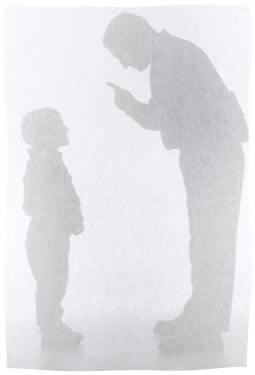 “The Rebbe once learned of a scheme to personally humiliate one of the Israeli prime ministers. He made every effort to stop the individuals from doing so. He said, ‘To rebuke their actions, yes; to humiliate them, no.’ “The Rebbe once learned of a scheme to personally humiliate one of the Israeli prime ministers. He made every effort to stop the individuals from doing so. He said, ‘To rebuke their actions, yes; to humiliate them, no.’
“It takes special strength to rebuke and love at the same time.”
This delicate and unique balance between love and rebuke, concern and compassion, truth and tolerance, recalls a different rebbe: Moses.
Final Words
As the book of Deuteronomy opens, Moses is left with five weeks to live.
He has lots to say to the people he’s led for forty years, and even more to say to a people whose promising but uncertain future looms just beyond the Jordan River.
The fifth book of Moses is thus, essentially, his last will and testament. Here’s how it begins:
These are the words “These are the words”—what words?that Moses spoke to all of Israel on the other side of the Jordan, in the wilderness, in the plain, opposite the Sea of Reeds, between Paran and Tophel, and Laban and Chatzeroth and Di-Zahab . . .
“These are the words”—what words?
This group of verses seems only to catalog the Israelite desert itinerary, making no mention of any words spoken by Moses. Were they perhaps edited out, one wonders?
The noted Bible commentator Rashi offers a creative insight.
“These are the words” refers to words of rebuke that Moses directed at the Israelites. Moses here enumerates all the places where the Jews angered G‑d.
Thus, “in the wilderness” is not a nostalgic reference to the setting of a memorable road trip, but serves to introduce a homily given by Moses to Israel, in which he recalls their many transgressions against G‑d, by means of mentioning the places where they fell short.
The geographical notes in these verses delineate Israelite pitfalls, not pit stops.
For example:
“In the wilderness” alludes to the time the Israelites angered G‑d in the desert, by saying, “If only we had died by the hand of G‑d.”1
“In the plain”: He rebuked them for their worship of the Baal Pe’or deity in the plains of Moab.2
“Opposite the Sea of Reeds”: A reference to their rebellion at the Red Sea, when they said, “Is it because there are no graves in Egypt that you have taken us to the desert to die?”3
And the list goes on (as enumerated by Rashi ad loc.) . . .
What’s puzzling here is the veiled way in which Moses chose to reproach his people. How out of character for a man whose hallmark was clarity and truth! Does not allusion leave room for confusion—problematic behavior for any leader, any time?
But here lays the true greatness of Moses, or rather the greatness of his truth.
The truth he embodied and communicated wasn’t the cold and metallic type, the variety which smacks of judgment, self-righteousness and condescension.
It was, rather, a warm and tender truth, packaged in an embrace, laced with sensitivity, and graced with compassion.
Thus, It was a warm and tender truth, packaged in an embrace, laced with sensitivitywhile these words of rebuke were absolutely necessary, when speaking them Moses made sure to allude instead of accuse, to beat around the bush rather than burn it down, in order to open, rather than close, the hearts and minds of the people he addressed.
He avoided hurt with heart. Moses taught that to humiliate is to annihilate. No matter the transgressor or transgression.
Thoughtful Omissions
There were, point out the commentators, two instances of national sin that Moses failed to mention in his last talk.
The first one happened at Marah: “They could not drink the waters at Marah because they were bitter. The people complained against Moses . . .”4
The second occurred in Kadesh: “There was no water for the assembly, and they gathered against Moses . . . They quarreled with Moses and said, ‘Why have you brought the congregation of G‑d to this wilderness to die here . . . ?’”5
What’s particularly striking about Moses’ omission of these transgressions is that these crimes were directed not (only) at G‑d, but at himself. We can just imagine how these accusations must have hurt—especially that mother-of-all-chutzpah tirade at Kadesh!
Not to mention that as an indirect result of that rant, Moses was dealt arguably the harshest blow of his lifetime: G‑d withheld from him the fulfillment of his lifelong dream of entering the Holy Land.6
Yet, amazingly, this calculated omission from his speech was not despite the hurt and betrayal he felt, but because of it.
Moses This calculated omission was not despite the hurt and betrayal he felt, but because of itworried that his personal grievance might somehow smuggle its way into his words or tone of voice when speaking to the Jews, and that as a result his words of admonishment would be tainted with a bitter edge, putting his listeners on the defensive, possibly pushing them further as opposed to the intended nearer.
This is the thinking of a leader in love with his flock. Of what use might referencing to Marah and Kadesh be in the grander scheme of things, if even a chance existed that it might stunt rather than assist the growth of his beloved people?
Moses recognized how sensitive people are when admonished, and adjusted and divested himself accordingly.
What’s in It for Me?
Sometimes it’s our responsibility to admonish. When that happens, we must ensure that there’s no bite in our bark. It will be picked up by the recipient, and the rebuke will be discarded.
By all means, hand out an earful when necessary; just make sure it’s full of heart.7
Rabbi Mendel Kalmenson is the rabbi of Beit Baruch and executive director of Chabad of Belgravia, London, where he lives with his wife, Chana, and children.
Mendel was an editor at the Judaism Website—Chabad.org, and is also the author of a popular book titled Seeds of Wisdom.
FOOTNOTES
1.Exodus 16:3.
2.Numbers 25:1–9.
3.Exodus 14:11.
4.Exodus 15:23–24.
5.Numbers 20:2–4.
6.See Maimonides’ “Eight Chapters” (introduction to Avot).
7.Based on the Rebbe’s talk delivered on Shabbat Parshat Devarim 5725 (1965).
© Copyright 2014, all rights reserved.
|
|
|
More in Parshah:
|
|
|
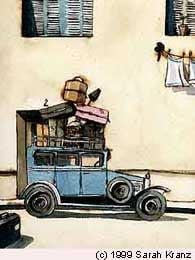 On the first of Shevat (thirty-seven days before his passing), Moses begins his repetition of the Torah to the assembled children of Israel, reviewing the events that occurred and the laws that were given in the course of their forty-year journey from Egypt to Sinai to the Promised Land, rebuking the people for their failings and iniquities, and enjoining them to keep the Torah and observe its commandments in the land that G‑d is giving them as an eternal heritage, into which they shall cross after his death. On the first of Shevat (thirty-seven days before his passing), Moses begins his repetition of the Torah to the assembled children of Israel, reviewing the events that occurred and the laws that were given in the course of their forty-year journey from Egypt to Sinai to the Promised Land, rebuking the people for their failings and iniquities, and enjoining them to keep the Torah and observe its commandments in the land that G‑d is giving them as an eternal heritage, into which they shall cross after his death.
Moses recalls his appointment of judges and magistrates to ease his burden of meting out justice to the people and teaching them the word of G‑d; the journey from Sinai through the great and fearsome desert; the sending of the spies and the people’s subsequent spurning of the Promised Land, so that G‑d decreed that the entire generation of the Exodus would die out in the desert. “Also against me,” says Moses, “was G‑d angry for your sake, saying: You, too, shall not go in there.”
Moses also recounts some more recent events: the refusal of the nations of Moab and Ammon to allow the Israelites to pass through their countries; the wars against the Emorite kings Sichon and Og, and the settlement of their lands by the tribes of Reuben and Gad and part of the tribe of Manasseh; and Moses’ message to his successor, Joshua, who will take the people into the Land and lead them in the battles for its conquest: “Fear them not, for the L‑rd your G‑d, He shall fight for you.”
© Copyright 2014, all rights reserved.
|
|
|
|
Essay
|
|
|
Meditation had
once been a jailbreak for the mind’s flight from the body. Now it became
a way for the body to join with the mind. In Tanya, the goal of both
meditation and prayer is to awaken a sense of love and awe that overflows
and sweeps up the beast in its path. To fix up that animal.
By Tzvi Freeman
There was a time when the Land of Israel was filled with teachers called nevi’im, and their students, b’nei ha-nevi’im. We call them prophets, but they were much more than that. They were spiritual seekers, men and women who left behind the vanities of the temporal world to live on mountaintops and in desert caves. There they meditated, strummed their instruments and chanted until entering a deep trance, visiting the higher worlds where things yet to come could already be perceived.
In later times, the sages of the Mishnah sat in circles, escaping their bodies to wander through heavenly chambers and perceive the secrets of the angels. Then there were the philosophers who sat in perfect stillness for endless hours contemplating existence and being, time and space. And the Kabbalists who attained visions and mystic union through meditation on combinations of Hebrew letters and connections of the sefirot.
But these were all special people, removed and aloof from the common person’s world. The ordinary man or woman, if inspired with love of G‑d, loved G‑d and did what was right to do. And if he or she felt no love, you still have to do what you have to do—either out of fear of punishment, anticipation of reward, or just plain habit.You cannot have love and awe towards an unseen Being you never think about.
Yes, our Torah says we must serve G‑d with love, with awe and with joy. But, as Maimonides wrote clearly, you cannot have such feelings towards an unseen Being you never think about. Emotions, the Zohar tells us, are children of the mind. Lasting, real emotions are born from a union of the mind with a higher vision beyond the mind. But if you are tied to the earth, the body and its pleasures, wrestling in the mud with incessant impulses, urges and desires, unsure how you are going to provide a meal for your family that day, how are you to sit and contemplate the mysteries of the universe and its Maker?
In the Presence of the Master
But then the Baal Shem Tov came and he taught that every one of us, no matter how entangled with this world, no matter how low it may have dragged us down, must awaken the innate love of our souls to serve the Creator with all our hearts. Wherever he went, he would share the words of the Zohar, sometimes in a whisper, sometimes yelling it from the top of a barrel in the marketplace: “G‑d wants your heart!”Eventually, someone had to write the do-it-yourself manual for us regular people.
In the presence of the Baal Shem Tov, no matter who you were, your heart caught afire with his love and joy. So too in the presence of his disciples, all luminous, radiant souls. But eventually someone had to write the do-it-yourself manual for us regular people to achieve that experience through our own hard work. Because it’s real only when accomplished through your own hard work.
That someone was Rabbi Schneur Zalman of Liadi, often known as the Baal ha-Tanya, after the small do-it-yourself manual he wrote that came to be known universally as the Tanya (the Aramaic word tanya is the first word of the book). He, however, called it Sefer Shel Beinonim, which could be translated as The Book for the Average Person. Or, more literally, The Book for Those In-Between.
A Guide For the Rest of Us
In between what? In between two conflicting personalities fighting it out inside a single body, a divine soul pulling upwards, and a beast pulling towards whatever feels good. This book was written to instruct us how to bring some heavenly peace and love into our down-on-earth battle zones. In other words, a book for the rest of us.
Much of the advice is radical and counterintuitive.
For one thing, we are told to embrace that inner struggle. Why? Because inner conflict is evidence that we are accomplishing something. If that beast inside you is not kicking back, it must be you’re not leading it anywhere. If you find it throwing you all sorts of wanton thoughts and wild impulses at you every time you try to do something good, that’s evidence that you’re riding the beast and it’s not riding you. Sit high in your saddle, remain the master, and you’ve already begun to tame your animal.
For another, we are told that closeness to G‑d is not reserved for those with access to the mountaintops. Closeness to the infinite is more about effort than altitude. The infinite G‑d can be found anywhere, at anytime, by anyone. On the contrary, it is in the lowest and most simple, the brokenhearted and the humble, that the Infinite Light may shine most pristine.
The stumbling blocks on the path to spiritual growth are sadness, feelings of inadequacy, unwarranted guilt, anxiety and a stuffed-up heart—and the prescriptions provided for these are almost always not what you would expect. Feeling inadequate? Stop setting unreasonable expectations—that’s pure arrogance. Disappointed with how life is turning out? Look deeper, see beyond your pain, and you’ll discover that all is for the good. Burdened by guilt? Leave that for a time when you can deal with it. At all times, serve G‑d with joy in all you do.
Meditation, Redefined
These were all foundational teachings of the Baal Shem Tov, clearly articulated and made readily applicable for all. Rabbi Schneur Zalman added a vital ingredient: He redefined meditation to make it accessible to this average, in-between warrior.Meditation had once been a jailbreak for the mind’s flight from the body. Now it became a way for the body to join with the mind.
Meditation had once been a jailbreak for the mind’s flight from the body. Now it became a way for the body to join with the mind. In Tanya, the goal of both meditation and prayer is to awaken a sense of love and awe that overflows and sweeps up the beast in its path. To fix up that animal.
To do that, Rabbi Schneur Zalman had to develop a way to explain the most esoteric Kabbalistic concepts—creation from nothing, the order of worlds and sefirot, the Infinite Light and the dissolution of being within that light, the soul and the purpose of its descent into a human form—to a beast. Meaning, not only to a G‑dly soul, but to a rational, human soul, and even to the beast pumping within the human heart, interested only in “what’s good for me.”
How did he do that? In major part by enlisting the human psyche as a map of the divine. We are constantly traversing worlds within ourselves, moving from the inner light of the soul through innumerable layers of desire, intellect, emotion, thoughts and words until radiating all the way down to the realm of real-life action. Our psyche even contains a magnificent model of creation ex nihilo—the emergence of articulate thought from emotion and intellect. By contemplating our own inner experience, we are capable of catching a glimmer of G‑d’s Infinite Light with our world and with ourselves. And that glimmer is all it takes to awaken the innate desire we all harbor to merge with that light, and our sense of awe standing before it.
Rabbi Schneur Zalman taught not only scholars, but also merchants, craftsmen and farmers how to contemplate ideas that were previously the domain of a select group of special souls. He brought many a stray soul back home, and they too learned to contemplate the divine. He called his method Chabad.
Meditation in Techno-Land
Rabbi Schneur Zalman lived and wrote on the cusp of modernity. The Tanya was composed as all of Europe was reverberating with the French Revolution. His heirs—six generations of them—succeeded in sustaining and developing his teachings through the rapid and often violent upheavals of the 19th and 20th centuries. Transplanting the meditative practice of Chabad from Eastern Europe to the high-strung, hyperactive techno-world of today has been challenging—especially when Chabadniks are scattered around the world, running a marathon to keep basic Jewish practice alive and well.If there ever was any era when Rabbi Schneur Zalman’s meditation-for-the-masses technique was most needed, it is today.
But if there ever was any era when Rabbi Schneur Zalman’s meditation-for-the-masses technique was most needed, it is today. Crowded between the tall concrete towers that hide us from G‑d-made nature, caught in a furious chase after career and status, our minds crammed with the noise of a thousand commercial messages per day, our emotions jaded by hyper-stimulation until we have lost the ability to cry, to stand in wonder, to love, to be real—what we need is a deep cognitive reframing of who we are and what is our world, a higher perception that provides not just purpose, but peace of mind and the fearlessness to carry out our purpose.
We have to redeem that gray matter in our skulls from the captivity of mass media. We have to reclaim it for our own good use, so we can transform our perception of life in this world, and thereby transform the world.
And once we have done that, we will learn to pray again: to stand within the empty hollow of the universe, our hands uplifted, our hearts bared, and call out with awe and with wonder, with love and with joy, “You.”
See Likkutei Torah, Bechukotai 47c. Sefer ha-Maamarim 5700, p. 92.
“Maamar Beyom Ashtei Asar” 5732. Philosophy of Chabad, vol. 2.
Rabbi Tzvi Freeman, a senior editor at Chabad.org, also heads our Ask The Rabbi team. He is the author of Bringing Heaven Down to Earth. To subscribe to regular updates of Rabbi Freeman's writing, visit Freeman Files subscription.
Chaim Leib (Leon) Zernitsky has created fine art and illustrations for international magazines, book publishers and major corporations for over 25 years. He has published over 30 books for children and young adults and won numerous awards. Chaim Leib feels that creating Jewish art is an important part of being a Jewish artist, and his paintings can be found in private collections worldwide.
© Copyright 2014, all rights reserved.
|
|
|
Jewish News
|
|
|
The Chabad Youth
Organization in Israel emphasizes its campaign for prayers on behalf of
hospitalized solders. Ten IDF troops were killed and more were wounded in
Gaza fighting on Monday. What you can do to help.
Chabad.org Staff
An IDF soldier wounded in combat in Gaza is led to the emergency room at Soroka hospital in Beersheva, after being evacuated from the field by helicopter. (Photo: Hadas Parush/Flash90)
Ten Israeli soldiers were killed on Monday, four in a mortar attack near the Gaza border, and five others who were defendng against an infiltration from a tunnel into a kibbutz, an IDF spokesman confirmed this evening. Six were wounded in the shelling, some critically, as Israel continued to bury its fallen soldiers throughout the day. The wounded were rushed to Israeli hospitals, where 122 combat troops were undergoing treatment for injuries sustained in the Gaza operation.
According to an IDF statement, funeral arrangements have been established for the five soldiers who were killed earlier in the day: SSgt. Eliav Eliyahu Haim Kahlon, 22, of Safed, one of four soldiers of the Armored Corps who was killed by mortar fire, will be buried at the military cemetery in Safed at 11 a.m.; Cpl. Meidan Maymon Biton, 20, of Netivot, will be buried at 3 p.m. on Tuesday in the city’s military cemetery; Cpl. Niram Cohen, 20, of Tiberias, will be laid to rest at 5 p.m. at the military cemetery in the city; SSgt. Adi Briga, 23, of Beit Shikma, will be buried at 4 p.m. at the military cemetery in Ashkelon.
SSgt. Moshe Davino, 20, of Jerusalem—a soldier in the Combat Engineering Corps who was killed earlier in the day in Gaza when terrorists fired a rocket at his vehicle while he and his fellow soldiers were uncovering a tunnel into Israel—will be laid to rest at 3 p.m. on Tuesday at the Mount Herzl military cemetery.
The IDF also announced early Tuesday morning that five IDF soldiers were killed when terrorists attempted to infiltrate Israel using a tunnel from Gaza Strip to Kibbutz Nahal Oz.
“The soldiers thwarted the attempt by identifying the squad and neutralizing one of the terrorists,” the IDF said in a statement.
The five soldiers killed in the tunnel attack are Sgt. Daniel Kedmi, 18, from Tsofim; Sgt. Barkey Ishai Shor, 21, from Jerusalem; Sgt. Sagi Erez, 19, from Kiryat Ata; Sgt. Dor Dery, 18, from Jerusalem; and Sgt. Nadav Raimond, 19, from Shdamot Devorah.
Funeral arrangements have not yet been announced for all of the soldiers killed during the tunnel infiltration. This raises the total IDF death toll to 53. Two Israeli civilians and a Thai worker have also died as a direct result of the conflict.
A Call for Special Prayers for the Wounded
Late last week, the Chabad Youth Organization of Israel placed ads in Israeli media providing the Hebrew names of injured soldiers, along with their mothers’ first names; listed the hospitals in which they are being treated; and called for prayers for their speedy recovery.
In addition to prayers for the wounded, thousands of people from Israel and abroad are doing the mitzvah of bikur cholim, (visiting the sick), spending time where permitted with soldiers at the hospitals where they are being treated.
As of Monday morning, 38 soldiers are undergoing treatment at the Soroka Medical Center in Beersheva; 30 are at the Sheba Medical Center outside of Tel Aviv; 34 are at the Barzilai Medical Center in Ashkelon; 19 are undergoing treatment at Beilinson Hospital in Petach Tikvah; and one soldier is currently hospitalized at Tel Aviv’s Ichilov Hospital.
For security reasons and so as not to overwhelm the sick, well-wishers are asked to contact the hospitals prior to arrival.
Specific prayers for the wounded soldiers, including a translation and transliteration of Psalm 20, can be found here.
Chabad.org has also set up a special web page where people can dedicate a mitzvah and write a note to IDF soldiers in general.
Mitzvahs and notes can be specifically directed to the wounded, and printouts will be hand-delivered by staff and volunteers of the Chabad Terror Victims Project.
Those wishing to write a letter and dedicate a mitzvah to IDF soldiers can click here to participate.
For more news, impressions, mitzvahs and prayers related to “Operation Protective Edge,” click here.
The following is the notice containing the Hebrew names of those who were hospitalized as of last Friday, along with their mothers’ names, which are to be used in prayers for a speedy and complete recovery.
Readers can click on the photo of the ad below for a full-size image of the ad for easier viewing of the names of the hospitalized soldiers.
An ad in Israeli media provides the Hebrew names of the injured, along with their mothers’ first names; the hospitals in which they are being treated; and Psalm 20.
An ad in Israeli media provides the Hebrew names of the injured, along with their mothers’ first names; the hospitals in which they are being treated; and Psalm 20.
© Copyright 2014, all rights reserved.
|
|
|
More in Jewish
News:
|
|
|
|
|
|
Luke Tumblin decided his Eagle Scout project would be to help fix up and furnish his local Chabad.
When Luke Tumblin, 13, was trying to figure out what to do for his Eagle Scout Service Project, he considered and discarded a number of ideas. The youngster, who hopes to reach the highest rank in the Boy Scouts of America, knew his project would have to help others and make a lasting impression on his community.
He considered the places and organizations that meant the most to him, and settled on the Alevy Chabad Jewish Center in Las Cruces, N.M., co-directed by Rabbi Bery and Chenchie Schmukler. It was there that he became a bar mitzvah and where he also still learns.
“I hang out a lot at Chabad, and we try to go to Friday-night services as much as we can,” says Luke, referring to his family. “And I noticed that the room for kids to hang out in was run-down, and I thought, ‘My Eagle project is coming up and I need to do a service project for a nonprofit—what better place than Chabad?”
The children’s area wasn’t so much run-down as it was unfinished, explains Rabbi Schmukler, noting that they recently renovated their building, and that the first priority was finishing the synagogue area. But with the launch of Hebrew school this fall, along with a local chapter of C-Teens (the Chabad-Lubavitch teen network), fixing up a classroom area (which the rabbi estimates is actually about a quarter of the building) took on a new sense of urgency.
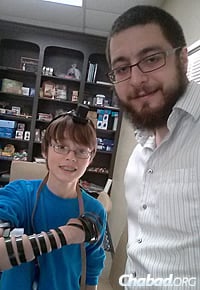 Luke wraps his grandfather's tefillin with Rabbi Bery Schmukler, co-director of the Alevy Chabad Jewish Center in Las Cruces, N.M. Luke wraps his grandfather's tefillin with Rabbi Bery Schmukler, co-director of the Alevy Chabad Jewish Center in Las Cruces, N.M.
Luke’s project really came at a fortuitous time.
“This is tremendous,” says the rabbi. “The only way we will be able to have a Hebrew school in September is if we have that room ready. We are trying to get the funds to put in air-conditioning, and we realize that it will cost about $8,000 to do that and more.”
The 13-year-old is working hard towards that effort. “Luke is hustling,” affirms the rabbi. “He’s spending his entire summer break pretty much on this, trying to get local stores to donate items.”
‘They Want to Help’
The eighth-grader’s determination has already paid off; he arranged to have tables donated to the synagogue by the local public-school system.
But the rest of his goals—from putting in window shades to getting bookshelves in and up, and painting the walls and lockers—will cost some money.
To that end, he is running two fundraisers. One is virtual: Through an online fundraiser, which kicked off less than two weeks ago, Luke is already more than half-way towards his online fundraising goal of $1,200 for the project.
The other is the brick-and-mortar sort—namely, a bake sale. With the support of his father, Michael Tumblin, and 16-year-old brother, Austin, coupled with the help of his mother, Gerri Tumblin, and Chenchie Schmukler, Luke spent most of last Wednesday at the Chabad center, making 10 large batches of challah dough.
On Friday, the 13-year-old sold challahs at Toucan Market, a local store that donated ingredients for the loaves; he made and braided more than 100 with the help of family and friends.
Because of the amount of challah made—some 100 loaves—Chenchie Schmukler asked a group of local women to join in the preparations. “They came and helped us braid the dough,” Luke says, “and we it got done in half the time.”
By 8 p.m. on Wednesday, more than $260 worth of challah had been sold (each loaf cost $5). So on Thursday, the boy and his mom made even more.
A local supermarket, Toucan Market, which had donated the ingredients for the challah, offered Luke a small table in their store on Friday, where he sold the remaining loaves before Shabbat, making a total of $660.
“I’m inspired that a kid at 13 sees what’s important,” says Rabbi Schmukler. “Luke always wants to help other Jewish kids in the community. He asks a friend to learn with him or come to an event.
“If you look at who’s donated so far, it’s his fourth-grade teacher, his friends, people he knew for years—they all know Luke can accomplish anything, and they want to help.”
As for Luke, who says he’s eagerly awaiting the launch of C-Teens this fall, “doing something for Chabad is a really good feeling. … I always want them to have something new.”
The future room for the Hebrew school and C-Teens program. Luke aims to paint, put up window shades and bookshelves; new flooring is also in the works.
© Copyright 2014, all rights reserved.
|
|
|
Girls at a Gan Israel summer camp in Kharkov, Ukraine. Jews are more than worried about the state of their country; the eastern part remains in a state of war-like conditions, with many fleeing and those remaining in need of basic necessities.
When Malaysian Airlines Flight 17 was blown out of the skies over eastern Ukraine last Thursday, killing 298 people, and scattering their bodies and body parts over swaths of yellow wheat fields, the world reacted with shock. The story of instability in Ukraine, which had dominated the media for months before slowly fading away, was suddenly thrust back onto center stage and in a more horrific way than anyone could have predicted.
Within days of the attack, U.S. intelligence joined the growing number of voices placing blame squarely on the shoulders of the pro-Russian separatists who control large sections of eastern Ukraine, saying they had fired an advanced surface-to-air missile at the Boeing 777. Once the missile was fired, the airliner had little chance of surviving; upon impact, the plane disintegrated in mid-flight, killing everyone on board.
“It’s a terrible situation,” says Rabbi Moshe Moskowitz, chief rabbi and head Chabad emissary of Kharkov, the largest city in eastern Ukraine and one that remains under Ukrainian government control. “In that area, anyone can have such weapons; it’s a mess. No one knows who has what weapons, and that’s a big problem.”
For some observers, even more appalling than the initial crash was the way in which the crash scene has been handled by rebels since the July 17 downing. For three days following the attack, bodies remained outside, decomposing in the sun amid widespread reports of looting. Separatists have since slowly started cooperating; yesterday, they finally handed over the plane’s black boxes to Malaysian investigators, while the bodies were transported by train out of Russian-separatist area and arrived in Kharkov.
“We have so far not heard of any Jewish passengers who were aboard the plane, but we are going to continue checking into that in case there is anything that will need to be done,” adds Rabbi Moskowitz’s wife, Miriam. “Despite how awful story this story is, people here have some hope that it has finally attracted the attention of the world and might actually bring this situation to an end.”
Caring for Refugees in Central and Western Ukraine
While life as normal continues in western and central Ukraine, the east—especially around the rebel-held cities of Donetsk (MH17 was shot down only 60 miles east of the city) and Lugansk—is ablaze, as Ukrainian security forces attempt to recapture the breakaway regions.
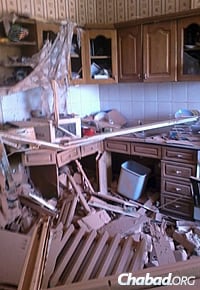 The damaged kitchen of a Jewish home in Lugansk, the result of shelling and fighting The damaged kitchen of a Jewish home in Lugansk, the result of shelling and fighting
Hoping to escape the shelling and chaos, Jewish community members have been fleeing Donetsk and Lugansk. Some are settling elsewhere until the unrest subsides; others are emigrating to Israel or elsewhere permanently.
The Jewish community in Dnepropetrovsk has been busily working to care for refugees that have arrived in their city, placing them in dormitories and old-age homes, as well as providing counseling for them.
Rabbi Shalom Gopin’s community in Lugansk has been one of the hardest hit since active fighting erupted in the city a few weeks ago. Gopin, who has temporarily relocated his family to Israel but remains in very close contact with Jewish community members who have remained behind, says some 40 people are living within the relative security of the dormitory at the Simcha Orphanage in Lugansk. There, they have stocks of kosher food and quick access to a fortified basement in case shelling begins.
Those who have not left yet are mostly the elderly and the infirm, as well as those too poor to buy tickets to board trains, which have become the sole way out of the city.
“There are tens of people dying in Lugansk every day,” states Gopin. “It’s a war. Grads and Katyushas are landing everywhere, blowing up houses and stores. It’s a horror!”
Svetlana Sitnikov and her daughter Anna Sitnikov were killed in an explosion on Friday in Lugansk. Anna’s 4-year-old son, Vadim, a student in the city’s Ohr Avner Chabad kindergarten, did not go with them at the last moment and survived.
But the Lugansk Jewish community has felt the war in a personal way as well. While out for a quick shopping run on Friday, Svetlana Sitnikov, 57, and her daughter Anna Sitnikov, 31, along with another six people, were killed in an explosion. Anna’s 4-year-old son, Vadim—a student in the city’s Ohr Avner Chabad kindergarten—did not go with them at the last moment, and so survived.
“Vadim attended our gan [preschool], they came to holidays, sometimes Shabbos as well; they were a part of our community,” says Gopin. Despite the difficulties involved, he hopes to arrange Jewish burials for the slain when it becomes possible.
Beginning on Sunday, exiles from Lugansk, along with those leaving and trying to leave the city, will gather at a family camp in the western city of Zhitomer, where they will have the chance to decompress and hopefully relax following weeks of explosions and months of stress. “The Sitnikov family was supposed to come to camp,” notes Gopin, who will be returning to Ukraine with his family to run the camp. “Now, Vadim will come alone.”
Rabbi Cares for War-Torn Donetsk Community
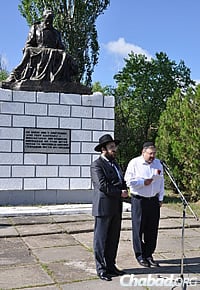 Rabbi Shalom Gopin, left, head of the Jewish community of Lugansk Rabbi Shalom Gopin, left, head of the Jewish community of Lugansk
In nearby Donetsk, where the situation has been tense for months, fierce fighting has broken open in the aftermath of the plane crash and now engulfs the city. When trains were halted following the city’s central train station being hit by explosions on Monday afternoon, those still in Donetsk were effectively locked in. A number of Chabad emissaries in the city, including the chief rabbi, Rabbi Pinchas Vishedski, have decided to remain together with the Jewish community there, ensuring that regular prayers and classes continue in the synagogue. They will also work to supply basic food and aid to embattled citizens.
As he prepares to return to Ukraine to reunite with his community—albeit in the relative safety of the Ohr Avner camp grounds in Zhitomer—Gopin reflects on what will be when the respite there comes to an end.
“The whole world is now watching and seeing what is going on in Ukraine now, so we hope that things will be calm again and back to normal by the time camp ends,” states Gopin. “If not, we are preparing contingency plans to help those who cannot go back and have nowhere to go. We are a community, and we will continue to help each other through all of this.”
A fund to assist the Jewish community of Lugansk can be found here.
A general fund on behalf of the Jewish communities in Ukraine can be found here.
Rabbi Moshe Moskowitz, chief rabbi and head Chabad emissary of Kharkov
Community members in Donetsk gathered recently to recognize 12 Tammuz, the birthday of the sixth Lubavitcher Rebbe, Rabbi Yosef Yitzchak Schneersohn, and the anniversary of his release in 1927 from a capital sentence and imprisonment in Soviet Russia.
© Copyright 2014, all rights reserved.
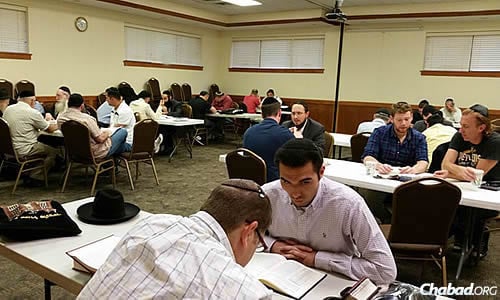 A room full of people participate in a new program called Bais Medrash Boker, an early-morning study hour before 6:30 a.m. prayers in Skokie, Ill. A room full of people participate in a new program called Bais Medrash Boker, an early-morning study hour before 6:30 a.m. prayers in Skokie, Ill.
Day was breaking, and the air was still cool as I walked through the double wooden doors of Lubavitch Chabad of Skokie, north of Chicago. It was a few minutes before 5:30 a.m., and I was there to join as many as two dozen “regulars” who gather every morning for an hour of free-style Torah study.
On my way in, I meet Aaron Miller, founder of an online retail outlet. In one hand, he is holding a fruit shake. His other hand balances a stack of books in Hebrew and English.
“It’s like pickup basketball,” he explains to me. “We have more and more people coming in, learning Torah, digging deep into the text and discovering that Torah is really fun.”
For years now, Miller and a few others have been gathering for an hour of study before 6:30 prayers; recently, he decided to invite the wider community. “When there is a room full of people—each individual or group really getting into what they are studying—there is an energy that just fills the room,” he says, “and you lose track of time.”
The program, called Beis Medrash Boker (“Morning Study Hall”), was officially launched just a month ago. On the first morning, the room was festooned with balloons and the walls decorated with posters with stick-figure art. While the balloons are gone, the room is now decked out with a growing core group of devotees.
One by one, more people come into the room, holding binders, Talmud, Tanyas and other assorted study materials. Many stop briefly to fill up their cups with steaming coffee from the well-stocked refreshment table.
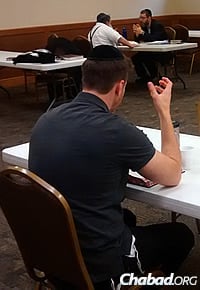 Aaron Miller deep in study. Aaron Miller deep in study.
Some people study alone, but most are in pairs. Among them are Chabad rabbis from nearby suburbs, in addition to local business people and others who have decided to join them. Miller tells me that a number of learners have now begun staying on for morning services as well—some for the first time.
“This program was created,” explains my study partner for the day, “to give each of us strength. Together, we can grow and toil in Torah, each of us motivating, encouraging and pushing each other to try new things and expand our horizons. Life is about growth. No matter what your background is, you can create a place in Torah that is uniquely your own. All you need to do is come at 5:30 with an empty coffee cup and an open mind.”
There are ambitious plans for the coming months. Alongside the regular students will be a weekly class in Chassidic texts with Rabbi Moshe Miller, an author and translator of Kabbalistic works from nearby Chicago.
Layers of Meaning
My partner and I chose to learn a teaching of the Rebbe—Rabbi Menachem M. Schneerson, of righteous memory—discussing the “wood chamber,” a structure in the Holy Temple in Jerusalem, which the High Priest would use as his personal quarters before and during Yom Kippur, when he performed the main rituals of the day.
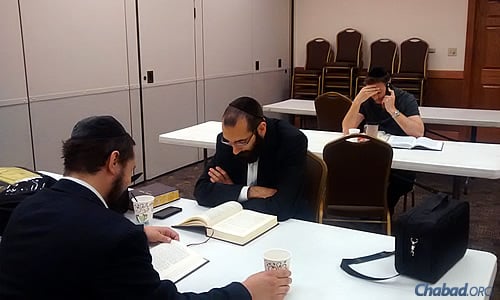 The goal? “To create a place in Torah that is uniquely your own. All you need to do is come at 5:30 with an empty coffee cup and an open mind.” The goal? “To create a place in Torah that is uniquely your own. All you need to do is come at 5:30 with an empty coffee cup and an open mind.”
The topic is intense, as the Rebbe’s words peel back layers of meaning, probing for the reason behind the room’s three names—the Talmud also refers to it as the “chamber of the courtiers” and “chamber of princes.”
As the hour passes, our table piles high with Mishnahs, Talmuds and other books referenced in the Rebbe’s essay.
As we wend our way through the subject matter, I glance at the clock. Time has moved all too quickly. We increase our pace, racing to finish the essay before 6:30.
“Gentlemen, your diligence is impressive,” a voice prods us, “but you are needed for the minyan.”
Looking up, I see that many of the groups remain hard at work as well, trying to cram in a few more precious lines of Torah. We get up and enter the sanctuary, just a bit late for services.
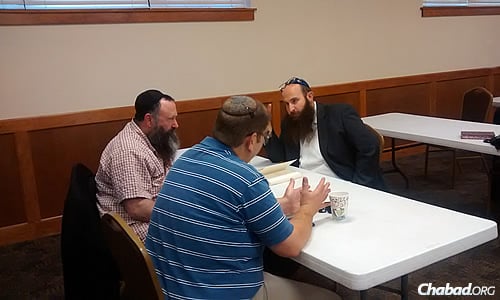 Participants bring binders, Talmud, Tanyas and other assorted study materials with them to learn from and discuss. Participants bring binders, Talmud, Tanyas and other assorted study materials with them to learn from and discuss.
© Copyright 2014, all rights reserved.
|
|
|
|
Stories
|
|
|
The prognosis
was that the boy would never walk, never talk and never develop much.
By Tzippy
Koltenyuk
The Bolton Family
Every Thursday, Bracha Bolton cooks and bakes food for Shabbat—but she never knows how many guests she’ll have. Anyone and everyone has an open invitation to the Boltons’ home in Meron. Hundreds of guests grace their Shabbat table every week. Their dining room is a distribution center for cakes and cookies and hot drinks at all hours. So many people come and go that their home resembles a train station during the day. At night, their dining room becomes a hostel for boys and men, while their living room becomes a giant dormitory for girls. All their bedrooms are given to couples, and when those are full, people sleep in tents on their lawn. Before Lag BaOmer, when thousands of people stream to Meron to visit the grave of Rabbi Shimon bar Yochai, Bracha prepared over 60 pounds of challahs, rolls and cakes, and that was just part of the food the Boltons distributed from their home.
No, the Boltons don’t earn a living from their extraordinary hospitality. Yosef Chaim Bolton is a personal trainer, and works in maintenance and as a security guard. Bracha, a talented and ambitious woman, is busy raising their six children, two of whom need exceptional amounts of warmth and wisdom. She loves to bake, and is hoping that someday she’ll have the time and money to make a business of it.
The doctors said, “It would be a shame for you to take him home”
Yosef is from Jerusalem, and Bracha is from Kfar Chabad. After a short period of dating, they felt that they were meant for each other. Exactly a year after their wedding, Bracha gave birth to their firstborn son. The birth was easy, and everyone was ecstatic.
Then their perfect happiness was shattered. The day after his birth, the doctors told Bracha and Yosef that the baby suffered from cerebral palsy. Their advice was to leave the baby in the hospital, or to arrange to transfer him to an institution. The prognosis was that the boy would never walk, never talk and never develop much. “It’s a shame for you to take on this burden. You’re a young couple, just starting out,” the doctors said. “Leave him and get on with your lives.”
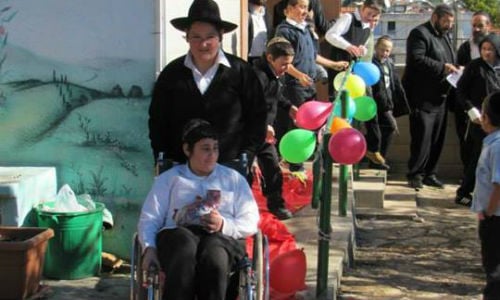 Mendel was greeted with joy after his school became wheelchair-accessible Mendel was greeted with joy after his school became wheelchair-accessible
The Boltons were crushed. But the moment they held their baby, they felt an overwhelming love for him. They decided together that this baby, with all his problems, had been sent to them by G‑d, and they were the ones who would raise him with love and go to any extremes to help him develop.
The Boltons named their son Menachem Mendel. Due to poor muscle tone, caused by cerebral palsy, it was hard for Mendel to eat and speak; each eye wandered in a different direction (a condition that was corrected surgically); and he was dependent on a wheelchair.
A year and eight months later, Bracha gave birth to another son, Rechavam, who was perfectly healthy. He developed quickly, soon overtaking Mendel in speaking, walking and other ways. It was hard to watch the disparity. When Mendel was three years old, his frustration at being unable to express himself became apparent. The Boltons sent him to a well-known, highly regarded professional who taught handicapped children to read and write. At the age of three and a half, Mendel still didn’t know how to walk and talk, but he knew how to read and write. This gave him the chance to express himself, and the confidence that came from knowing that at least in reading he was ahead of his little brother.
Bracha and her husband traveled several times a week from Kfar Chabad to Jerusalem for physical therapy, hydrotherapy, speech therapy, homeopathic treatments and other treatments, trying every intervention to help Mendel develop.
In spite of the doctors’ negative prognosis, when he was four, Mendel began to walk and talk. The family was enormously excited. Even after Bracha gave birth to two healthy, beautiful girls, she and Yosef Chaim continued to give Mendel whatever help they could to enable him to lead a full life. Mendel participated in every family trip; he was never left out because of his limitations.
The Boltons had always felt a special connection to the grave of Rabbi Shimon bar Yochai in Meron. They would go there to pray every Rosh Chodesh, often taking the children with them. They decided to move to Meron when Mendel was nine years old. They were enchanted by the spaciousness, the fresh air, and the holiness and serenity of the little village.
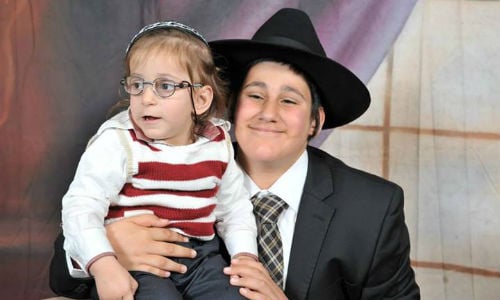 Mendel with his brother Shlomo Dovid Chai Mendel with his brother Shlomo Dovid Chai
The hardest part of the move was Mendel’s transition to a new school. In his old school, he was much loved. The teachers taught the students to see the amazing child behind the disabilities and the wheelchair. In his new school he had to endure the stares of children who didn’t understand his challenges, and the staff were nervous about their new responsibility. But after several long months, Mendel participated in a party celebrating the class’s achievements in learning Talmud. The principal approached Bracha at the party to praise her special son Mendel, who was beloved by all the students and the whole staff.
From a young age, Mendel was strongly attracted to the Rebbe. He would watch videos of the Rebbe for hours, paste stickers and pictures of the Rebbe all over, and read the Rebbe’s books. When he was hurt, he could be comforted only by looking at pictures of the Rebbe. When the family moved to Meron, he became very attached to the grave of Rabbi Shimon bar Yochai, a renowned place of prayer. He insisted on being brought there every Shabbat. Even though it’s a brisk twenty-minute walk, Yosef Chaim attaches Mendel’s wheelchair to his gartel (belt) and off he goes, paying no mind to the weight he’s towing. Neither rain nor blistering sun can deter Mendel from his determination to go to the grave to pray.
The synagogue that Mendel’s school uses for morning services is not wheelchair-accessible, so every morning Bracha takes Mendel to Rabbi Shimon’s grave to pray, and the school bus picks Mendel up from there. The residents of Meron, the guards at the gravesite and the people who come to pray there all know and love Mendel.
A new challenge
Two years ago, Bracha gave birth to her fifth child, Shlomo Dovid Chai. At first Shlomo developed normally, but when he was a few months old, Bracha noticed that he wasn’t functioning well. Imagine the Boltons’ surprise when tests showed that little Shlomo, who looked exactly like Mendel, suffered from the same problems. Bracha and Yosef felt a sense of déjà vu as they scrambled for tests and evaluations. The pain that had been deeply buried in their hearts for eleven years rose to the surface.
Coping through giving
The way the Boltons cope with their challenges is to give of themselves to others.
The Boltons’ house is always open to the many visitors to Meron who find themselves without a place to sleep or eat. You might think that a couple caring for two handicapped children would have their hands full, but Bracha says that when giving to others, she and the children get more than they give. When they give to others, the house fills with joy.
“My children don’t know what a Shabbat without guests is. They love the experience and meeting new people every week. Once I wasn’t feeling well and decided to make a Shabbat just for us, but when my husband came home from the synagogue, he said that five children who had no place to eat would be joining us. Our kids were so happy. They scurried to organize a place for them. There was plenty of food, since I’m one of eleven children and don’t know how to cook in small amounts. When they came, I realized that this was an old friend of mine whom I hadn’t seen in years. She and her husband had rented a bungalow in Meron and ordered food from a takeout place. The restaurant left the box with their food outside their bungalow, but by the time she and her husband arrived, someone had taken the food. When her husband saw Yosef Chaim in the synagogue, he asked, ‘Where are you staying?’ My husband told him, ‘We live in Meron now, and you’re invited to eat with us.’ It was one of the best Shabbats we’ve ever had. I could see that G‑d was making sure we’d always have guests and that we’d always have enough for them.”
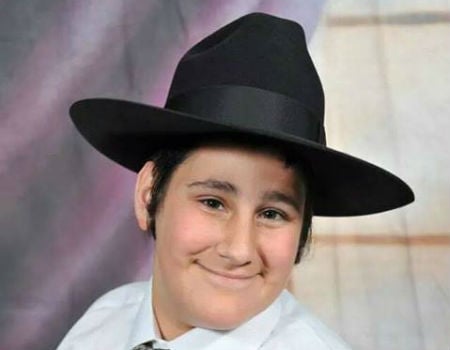 Mendel Bolton on the day of his bar mitzvah Mendel Bolton on the day of his bar mitzvah
When Lag BaOmer approaches, the Boltons’ freezers fill with food, tables are taken out of storage, and the whole house is made ready to welcome as many guests as possible, all at the Boltons’ personal expense.
I asked Bracha, “Isn’t all the tumult hard on you?”
“Hard? We wait for it every year. Lag BaOmer gives us stores of energy that last us all year.”
How do you finance all this hospitality? It must cost a fortune!
“The money comes through the blessings of Rabbi Shimon bar Yochai. There can be no other explanation. There are times when I ask my husband, ‘How will we manage? Where will we get the money for more food?’ In the end, we always manage. We’ve understood for a long time that hospitality is the source of blessing in our home. I have no words to describe how happy it makes me. Hundreds of Jews of all different nationalities and ethnic groups, from all over the world, come and make blessings on the cookies I baked. There is such a sense of holiness that comes from the unity and love that fills our home. You’d have to come here to understand.”
Bracha hurries to add that she’s inviting anyone who’s interested to come to the Bolton home in Meron.
Do you have a message for parents of special-needs children?
“The first stage of shock and grief, when your dream of having a healthy, successful child is shattered, is a normal stage. But you’ve got to keep it brief. If you get stuck mourning the child that isn’t, it will be impossible to love your child and to help him develop. If you hide him at home and are embarrassed by him, he’ll be ashamed of who he is. The moment that you believe in your child, the moment you love him and accept him for who he is, even with all the difficulties his care entails, the child becomes self-confident and begins to progress. You have to give lots of love and hugs, and to accept the child, to tell yourself that this is the gift that G‑d gave you and that you’re going to do your best with him.”
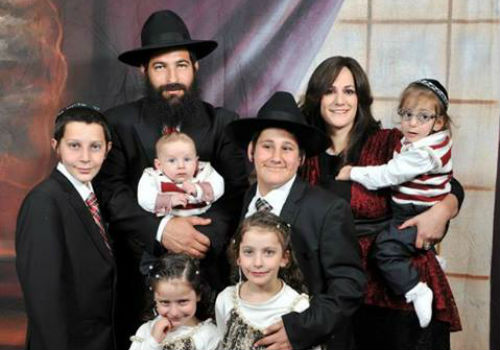 The Bolton family. Their door is always open The Bolton family. Their door is always open
A year ago, the Boltons celebrated Mendel’s bar mitzvah. This child, who the doctors said should be left in an institution because he would never walk or talk or succeed in anything, now walks, sits, speaks and functions. He’s putting on tefillin and is excited about his life, like any other child. It’s all due to the love and the enormous investments his parents made in him. At his bar mitzvah the family showed a film, “A Day in the Life of Mendel.” Everyone who watched it was crying when they saw how a child who suffers from multiple handicaps lives a full life and carefully observes mitzvahs, from the moment he washes his hands in the morning until he says Shema at night, all with a smile.
Such children have highly elevated souls that were put into an imperfect body. “It’s not easy to raise such a child, but it’s an enormous merit,” says Bracha.
Translated from the Hebrew by Esther Rabi.
Tzippy Koltenyuk is a public speaker, singer and creative writer.
© Copyright 2014, all rights reserved.
|
|
|
More in Stories:
|
|
|
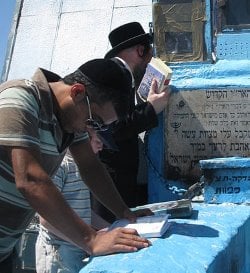 Rabbi Isaac Luria, known as the Holy Arizal (1534—July 25 [5 Av] 1572), was a mystic and sage whose teachings revolutionized the way we view the Kabbalah, G‑d, and our world. He was known, among other things, for his ability to arouse people to return to a Torah way of life. Hundreds of years after his passing, in wondrous ways, this holy man is still leading people toward Jewish connectedness. Rabbi Isaac Luria, known as the Holy Arizal (1534—July 25 [5 Av] 1572), was a mystic and sage whose teachings revolutionized the way we view the Kabbalah, G‑d, and our world. He was known, among other things, for his ability to arouse people to return to a Torah way of life. Hundreds of years after his passing, in wondrous ways, this holy man is still leading people toward Jewish connectedness.
Consider the following true story I heard from a friend:
After serving in the Israeli army and visiting India, I moved to Miami, Florida. Divine providence arranged that the apartment I rented was previously occupied by a religious Jew. “Accidentally,” he had left behind a book with the Arizal’s commentary on Chumash (the Five Books of Moses). For whatever reason, I kept the book in the living room above my television set. Every night, I read from this book. I wasn’t able to understand everything. But I absorbed a good deal, and it spoke to me. Every night, I would study some more. That forgotten volume awoke within me the stirrings of Jewish awareness that brought me back to my roots.
But this is not the end of the story. His future wife also found her way to Torah Judaism due to the Arizal’s influence. This is her story:
I was a secular girl living in Carmiel, Israel. I had very little connection to Judaism, but one of my friends had become religious. When she was pregnant with her first child, the doctors suspected complications, and they prescribed bed rest in the hospital for the months leading up to the birth. She was very worried, and she asked me to pray for her near the Arizal’s tomb in Safed. I had never prayed before, certainly not at a grave, but for my friend’s sake I agreed.
Soon afterward, however, I regretted my promise. I wasn’t sure that I wanted to make this effort; my belief in prayer wasn’t very strong at that point in my life.
I decided to go to the bus station and wait until the first bus arrived. If it was going to Safed, I would take it as a sign from heaven that I should go. Otherwise, I would return home.
Amazingly, the first bus that arrived was going directly to Safed. I later learned that there were only two buses going to Safed from my hometown every day.
Once in Safed, I stood before the Arizal’s grave, and it began to rain. The atmosphere suddenly made me very emotional. I prayed for my friend, for a healthy and easy childbirth, and then I began praying for myself. I had my own issues and needs, and my heart opened up in prayer. It was the first time I had ever prayed. I said, “G‑d, if You hear what I am saying, and if You care about me, help me. Show me the way . . .” I cried, I prayed, my tears mixing with the drops of rain. This was the turning point in my life. This day led me on my path of teshuvah (returning to observant Judaism).
Boston-born Boruch Twersky lives in Beitar, Israel, with his wonderful wife and 14 children. He has spent several years pursuing advanced Torah learning in kollel, authored many articles and translated a number of books. He is currently working on two books of his own.
© Copyright 2014, all rights reserved.
|
|
|
|
Multimedia
|
|
|
The astrological
sign of the month of Av is connected with a lion, and represents a month
of enormous potential and also great tragedy. Just as healing and
redemption follow the fires of destruction, similarly in our lives, our
challenges are divine gifts helping us to move forward.
By Shimona
Tzukernik Watch (10:25) Watch (10:25)
<script language="javascript" type="text/javascript" src="http://embed.chabad.org/multimedia/mediaplayer/embedded/embed.js.asp?aid=2266906&width=auto&height=auto"></script><div style="clear:both;">Visit <a href="http://www.chabad.org/multimedia/default_cdo/aid/591213/jewish/Video.htm">Jewish.TV</a> for more <a href="http://www.chabad.org/multimedia/default_cdo/aid/591213/jewish/Video.htm">Jewish videos</a>.</div>
|
|
|
More in
Multimedia:
|
|
|
http://www.chabad.org/multimedia/media_cdo/aid/759446/jewish/The-Story-of-Water.htm
http://www.chabad.org/759446
|
|
|
|
Women
|
|
|
It might be
awkward and not my style right now to say it, but I do love you . . .
By Nomi Freeman
1. I don’t really think you are stupid and ignorant. I just need to affirm my existence by thinking differently than you.
2. I’m no longer a child, and I want to make my own decisions. When you make all my decisions for me, I need to rebel to assert my independence. When you tell me you trust my judgement, even in small things, I feel validated and don’t need to rebel as much.
3. I feel good when you ask for my opinion. When you show respect for my ideas—as ridiculous as they may seem to you—I feel safe opening up to you. I am no longer a childYou show respect by listening attentively to my thoughts in a nonjudgmental way. If you can do that, we can start to talk.
4. When you start lecturing, I stop listening. When you think I’m wrong and the issue is really vital, asking questions gently to guide my thoughts in another direction works much better than a lecture. So does showing information from reliable sources. Trying to impose your views on me might make you feel powerful, but it makes me clam up and run away.
5. Appreciation is great . . . just remember that I’m not a kid! So don’t say “Good boy” or “You’re finally listening to me.” That would be a prescription for immediate rebellion. Appreciation sounds like “I really admire how responsible you are about your Sunday job,” or “Thank you so much for cleaning the kitchen. I was too tired to do it.” Basically, show me appreciation in the same words you would say to your friends.
6. Trust is so powerful. When you show me that you trust me and my abilities, I feel good about myself and about you, and I don’t want to disappoint you.
7. When you speak negatively about my friends, I dislike you, not them.
8. I dress the way I dress to assert my independence. And sometimes to gain recognition. If you throw a fit because you don’t like my style, you fall into a trap. You prove I can push your buttons.
9. It’s much easier to respect you when you respect yourself and others. Respecting yourself includes keeping calm and speaking in a kind way, even when you really don’t like what someone else is doing. Respecting others includes your children. Then, if I ever lose my cool and raise my voice, you’ll be able to say, “I don’t yell at you. Please don’t yell at me.”
10. My body is changing, my hormones are raging. I have too many teachers, and each of them gives us work as if nothing else existed. I worry about the horrible acne, the terrifying exams, the popular kid who’s not my friend. The math teacher doesn’t like me, and I don’t know what’s going on in biology. My friends are applying for jobs at a summer camp, and I don’t know if the camp will accept my application. I worry I might have bad breath, and I worry the other kids might speak about me behind my back. I don’t talk about all this because I'm overwhelmed and embarrassed. So please don’t get upset at me if my room is a mess or if I act grumpy. I need support, not lectures.
11. Don’t ask too many questions. It’s sooooo annoying. If you listen with interest and don’t criticize, I might share on my own.
12. Nobody likes to be bossed around. If you tell me you expect me to wash the dishes, clean the car, take out the garbage . . . I don’t like it. But if you say, “We are a family and we share responsibilities. Your father and I work and do XYZ. But we can’t do everything. We need our children to pitch in. Don’t ask for more than I can handleWe all want to make this a nice home”—that makes sense and I don’t feel treated like a kid. It’s also easier when you show me a written list of chores and ask me to choose which ones I’d like to do. And please, don’t ask for more than I can handle.
13. In my friend’s house, the family eats dinner together almost every night. And they have a rule: No devices at the table. The parents and kids talk to each other about their day, what’s coming up in the next few days, or whatever else is on their minds.I know I text at the table, but I secretly wish we were like my friend’s family.
14. Sometimes I want to be an independent adult. Sometimes I feel I’m growing up too fast, and I want you to take care of me. I actually like it when you know how to give advice in a smart way. You know, like when we’re just chilling, having a chat. You talk to me like one adult talking to another, and you give me a little advice—sort of in a friendly, caring way, but not a bossy, top-down way. Not often; once in a while. I kind of like that.
15. It might be awkward and not my style right now to say it, but I do love you. I’ve always loved you. I think one day I’ll be able to say it again. In the meantime, bear with me.
Sources:
Principles of Education and Guidance, ch. 14; Ethics of Our Fathers 4:12, and Bartenura and Rabbeinu Yonah ad loc.; Tanchuma, Beshalach 26; Mishneh Torah, Hilchot Talmud Torah 5:12; Rashi, Exodus 17:9; Sefer ha-Sichot 5704, pp. 92–94; Igrot Kodesh of the Rebbe Rayatz, vol. 4, pp. 302–3; Igrot Kodesh of the Rebbe, vol. 12, p. 100.
Nomi Freeman is the daughter of the renowned Argentinian Kabbalist Professor Avraham Polichenco, of blessed memory. She is well known for her seminars on spirituality and Jewish mysticism. Mrs. Freeman has lectured extensively in Canada and abroad. Contact her here for lecture engagements.
© Copyright 2014, all rights reserved.
|
|
|
More in Women:
|
|
|
Dear readers,
 Yellow. What mood does it evoke in you? Sunshine. Brightness. Happiness. Yellow. What mood does it evoke in you? Sunshine. Brightness. Happiness.
How about black? Darkness. Mourning. Despair. Constriction.
Do you have a favorite painting or portrait? Examine it closely. What do you like about it? Is it colorful? Vibrant? Realistic? Does it make you happy?
Look carefully at its colors. While it may have many hues, no doubt it has a good amount of black. The black is evident in its outline, in its shadows, in the blending of the colors and in making the brighter parts really stand out. It’s not only that the black serves as a backdrop for the lighter tones, but that, ironically, black illuminates and enhances the effects of all the other colors.
Unfortunately, life is like that too. We have sunny days where we feel at peace with our inner selves and aligned with our mission in this world. And then we have cloudy, gloomy and dark days in which we are out of sync. These are the times in our lives that are painful, full of unused potential, when we feel disconnected from our spiritual selves and our Maker.
Yet, often it is precisely in the blackness and difficulties of our lives that our fortitude, faith and strength as human beings emerge. Those circumstances highlight the beautiful hidden vibrancy of our inner souls and bring out their luminosity.
Just as anxiety is meant to agitate us into action, darkness too must be used as a springboard for further growth, to acquire a deeper sensitivity. There is a chassidic saying that nothing is as whole as a broken heart—as long as our grief is constructive, creating turmoil that brings us to action.
We are currently in the darkest period of the Jewish calendar, culminating with the 9th of Av, which marks the destruction of the first and second Temples.
But Jewish history is anything but tragic. It is a tale of hope, faith and optimism, of strength, morality and light triumphing despite the harshest circumstances. Centuries of exile have wrenched the Jewish soul through the most miserable darkness, but through it all we have triumphed in still being here, still searching for goodness and G‑dliness, still holding on to our deepest convictions and still striving to reach our highest potentials.
Over the last many weeks we have witnessed collective tragedy. The kidnapping of our boys united us all in sorrow and grief, as did the rockets that rain down upon our cities. But the emerging messages of each of these horrors demonstrate once again the amazing fortitude of the Jewish soul.
Moshiach is born on the ninth of Av. Together let us all beseech our Maker that the living “portrait” of our people has been painted with enough blackness to bring out our inherent beauty. It is now time to experience the sunny brightness of the other, happier hues.
It is time for us to experience “G‑d will wipe away the tears from every eye.” Forever.
Chana Weisberg,
Editor, TJW
Chana Weisberg is the editor of TheJewishWoman.org. She lectures internationally on issues relating to women, relationships, meaning, self-esteem and the Jewish soul. She is the author of five popular books.
© Copyright 2014, all rights reserved.
|
|
|
 “Only a nobody walks in L.A.,” declares an ’80s song that is still stuck in my head. While attending university in Southern California, I started taking the bus to campus to avoid receiving any more parking tickets. If you’re familiar with the poor public transportation system in L.A. in those days, you know how unusual that was. I had officially become a nobody, and I was thoroughly enjoying it! “Only a nobody walks in L.A.,” declares an ’80s song that is still stuck in my head. While attending university in Southern California, I started taking the bus to campus to avoid receiving any more parking tickets. If you’re familiar with the poor public transportation system in L.A. in those days, you know how unusual that was. I had officially become a nobody, and I was thoroughly enjoying it!
One afternoon, as I neared my house, I noticed that my car, which was parked on the street, looked different. I moved closer and saw it—the dreaded orange metal boot! Oh, no! Parking enforcement, my nemesis, had caught up with me. I had more than five unpaid parking tickets, “Only a nobody walks in L.A.”and the only way to have the boot removed was to pay the tickets in full—a hefty sum for a college student living on student loans.
Sobbing uncontrollably, I sat in my room and contemplated my awful fate (okay, a little dramatic, but I was prone to catastrophic thinking). This would cost me a lot of money that I did not have, and a lot of aggravation to get it removed. I needed to borrow the money to pay the tickets, borrow a car to go downtown to the courthouse, and pay the fines. I then had to set a court date in order to have a judge hear my case and determine whether I was truly liable for all those parking tickets. All this felt overwhelming, as finances were really tight and my schedule, between classes and work, was really packed. Why did life have to be like this?
Once I calmed down, I began to really analyze the situation. I had recently begun taking a few Torah classes from a Chabad rabbi on campus, and he often discussed divine providence, the belief that everything that happens in this world, even the most most seemingly insignificant thing, is purposefully ordained by G‑d. It was as if a light went on in my head—G‑d could take away my time and money, and He could just as easily give it back!
Up until then, I had never integrated the idea of divine providence into my psyche. But this boot was the segue that slowly changed my worldview and allowed me to accept the idea that G‑d is in control, not me. I could have used the boot as a reason to display anger toward G‑d. I could have partaken in a grand pity party. But instead, I made the conscious decision to see where this would all lead. Somehow, even back then when I was so new to understanding Judaism, I knew that this was a major game-changer.
At the time I was formulating my summer plans, debating whether to work as a cook in a Jewish sleepaway camp on the East Coast, or go to the Catskill Mountains with a program that taught young Jewish college students all about their Jewish heritage. The program in the Catskills was for only one month, and I would come back home in the middle of the summer, which would make it difficult to find summer employment. The other job would entail working in the kitchen, not ideal in my mind at the time, but at least I would earn money the entire summer.
Once I recognized that getting the boot was divine providence, I also realized that my inner debate about my summer plans was more than a practical calculation. It was really about making a commitment to live life on a different plane than I had been living the past twenty years. It was about finally recognizing that G‑d is in control of all things, big and small. So, at that moment, I decided that I really wanted to go learn Torah in the Catskill He can give me the boot, then find a way to reimburse the cost.Mountains. I knew that G‑d would take care of me, and I would be paid back for the money I thought I would miss from having gainful employment as a cook in a summer camp. This was divine providence at its best—all I needed to do was recognize how this boot on my car was really a huge gift!
I spent half that summer in a Torah environment, learning and building a foundation for my future. I made the commitment to be a true Torah Jew and to continue learning and taking on new mitzvahs after returning home.
I am convinced that my new attitude contributed to the events that unfolded that summer. First, when I came home from the learning program, I was able to get back the part-time job I had held during the school year. Second, when I went to court, all my tickets were dismissed, and I received back all the money I had previously paid. I used the money to purchase some much-needed mezuzahs for my home!
The best part of this whole adventure was that from that day on, I made a conscious decision to realize that everything that happens is divine providence. G‑d is in control of everything that happens. He can give me the boot, then find a way to reimburse the cost. Yet best of all, He can turn this nobody who walked in L.A. into a mother of many who would spend more than two decades driving around in a minivan. But when I get the chance, I still walk in L.A.
Batsheva Isaac lives in Los Angeles, is married and has 8 children. She works as a high-school principal and also runs an educational consulting firm. Batsheva became observant while attending UCLA in the ’80s.
© Copyright 2014, all rights reserved.
|
|
|
|
Lifestyles
|
|
|
An easy dairy
dinner for the 9 days
By Miriam
Szokovski
The first nine days of the month of Av are a period of mourning over the destruction of the Temple. During this time we refrain from a number of things, including drinking wine and eating meat or poultry (with the exception of Shabbat). So today I’m sharing a simple pasta bake you can make for a relatively quick and easy dinner.
You’ll need to sauté finely diced purple onion, zucchini, red pepper and button mushrooms. Onions take the longest, so start with those. Sauté the onions over a low flame until soft and translucent, approximately 15 minutes. Then add the zucchini and peppers and sauté until just wilted—approximately 2–3 minutes. The mushrooms cook the quickest, so add them last for about a minute.
Cook the pasta al dente. Rinse and drain.
Cook the sautéed vegetables with the milk, ricotta, shredded cheese and spices until cheese is melted. Stir in the cooked pasta and pour the mixture into a 9″ × 9″ square pan. Sprinkle with a mixture of breadcrumbs and parmesan cheese.
Cover the pan with foil and bake at 350° F for 25 minutes. Uncover and bake for another 20 minutes. Remove pan from the oven and let sit for 10 minutes before serving.
Ingredients
- 1 purple onion, finely diced
- 1 red pepper, finely diced
- 1 small zucchini, finely diced
- 4 button mushrooms, finely diced
- 1 tsp. salt
- ¼ cup olive oil
- 8 oz. raw pasta, cooked (half a box)
- ¾ cup ricotta cheese
- ½ cup milk
- ¾ cup shredded cheese (I used a mixture of cheddar and mozzarella)
- 1 tsp. oregano
- ½ tsp. garlic powder
- ½ tsp. kosher salt
- ½ cup panko crumbs or cornflake crumbs
- ¼ cup parmesan cheese
Directions
- Cook the pasta al dente. Rinse and drain.
- Sauté the onions in the oil and 1 tsp. salt until translucent and soft. Add the zucchinis and peppers and sauté until just wilted. Add the mushrooms and sauté for another minute or two.
- Add the milk, ricotta, shredded cheese, oregano, garlic and salt and cook until cheese is melted. Mix in the pasta and pour mixture into a 9″ × 9″ baking dish. Top with panko crumbs and parmesan cheese.
- Cover the dish and bake at 350° F for 25 minutes, then uncovered for another 25 minutes.
- Serve warm.
Yields: One 9″ × 9″ square pan.
Miriam Szokovski is the author of historical novel Exiled Down Under, and a member of the Chabad.org editorial team. She enjoys tinkering with recipes, and teaches cooking classes to young children. Miriam shares her love of cooking, baking and food photography on Chabad.org’s food blog, Cook It Kosher and in the N'shei Chabad Newsletter.
© Copyright 2014, all rights reserved.
|
|
|
More in
Lifestyles:
|
|
|
Ink, colored pencils, chalk pastels, and oil pastels on bristol board
Artist’s Statement: This piece is a Hamsa-shaped depiction of the book of Jonah, in which the prophet Jonah tries to flee G‑d’s command and is swallowed by a whale.
Brooke Sendele is an observant Jewish artist living in Tempe, Arizona. In May 2013 she graduated from Arizona State University with a BFA in Art-Drawing. She has taught art to elementary aged children at the JCC in Irvine, California, and at the Torah Day School of Phoenix. She is currently building up a portfolio of modern Jewish drawings. Her goal is to present aspects of Judaism and Jewish culture in a modern light.
© Copyright 2014, all rights reserved.
|
|
|
|
|
|

